#Church of Saint Anthony of Lisbon
Explore tagged Tumblr posts
Text





Feast of St. Anthony
The Feast of St. Anthony is observed every year on June 13 to honor the life and work of St. Anthony of Padua, who accomplished many things during his short time in this world as a priest. He was revered by his contemporaries and noted for his powerful preaching, vast knowledge of scripture, and undying love and devotion to the poor and the sick. They made him one of the most quickly canonized saints in church history. His fame spread through Portuguese evangelization and he became the patron saint of Lisbon, Padua, and many other places in Portugal. St. Anthony is invoked and respected around the world as the patron saint for the recovery of lost items. He is credited with several miracles involving lost people, things, and even spiritual goods.
History of Feast of St. Anthony
St. Anthony of Padua was born Fernando Martins de Bulhões to a wealthy and prominent family in Lisbon, Portugal on August 15, 1195. His father, Martin de Bouillon, was a descendant of Godfrey de Bouillon, commander of the First Crusade, while his mother, Theresa Tavejra, was a descendant of the fourth king of Asturia, Froila I.
Anthony was educated at the Cathedral School of Saint Mary near his house, where his teachers suggested that he become a knight at the king’s court. However, his father believed Anthony was better suited to intellectual pursuits and wanted him to help manage the family’s estate and become a nobleman. To his father’s dismay, Anthony joined the Canons Regular of St. Augustine when he was 15 and entered St. Vincent’s convent of Lisbon in 1210. Anthony soon asked to be transferred to the Holy Cross Monastery in Coimbra where he spent eight years studying theology and was later ordained a priest. During this period, he befriended many friars following Francis of Assisi, who built an order of friars and traveled extensively, preaching to non-believers.
In 1220, he joined the Franciscan order inspired by five Fransicians who were martyred in Morocco. He, too, hoped to preach to Muslims and be martyred. On his way to Morocco, he became seriously ill and was forced to return home, but his ship back to Portugal was blown off course and finally landed in Sicily. Because of his deteriorating health, he was not allowed to pursue missionary work. Instead, he taught theology in Bologna, Italy; and at Montpellier, Toulouse, and Puy-en-Velay in southern France. He won great admiration as a preacher and was noted for his simple yet profound teaching of the Catholic faith. He died on his way to Padua, Italy on June 13 in 1231.
Feast of St. Anthony timeline
1195
Saint Anthony is Born
St. Anthony of Padua is born Fernando Martins de Bulhões to a wealthy and socially prominent family in Lisbon, Portugal.
1220
The Franciscan Order
Anthony joins the Franciscan order, hoping to preach to Muslims and be martyred.
1231
Saint Anthony Passes Away
Anthony becomes sick with ergotism and dies on June 13 on the way to Padua, where he is now buried.
1232
Canonization
Anthony is canonized by Pope Gregory IX on May 30, 1232, at Spotelo, Italy for his spiritual teachings and devotion to the Church.
Feast of St. Anthony FAQs
What do you eat on St. Anthony’s day?
Spaniards are fond of beans and prepare them in many ways. Bean and Escarole Soup with or without pasta is often cooked in Spanish families and is offered to the poor on St. Anthony’s Day after Mass.
Where is the town of Braham located?
St. Anthony had a prized and expensive book of psalms that went missing and he thought was probably stolen. He prayed that the book would be found. A novice who had taken the book suddenly returned it and even returned to the order. The stolen book is said to be preserved in the Franciscan friary in Bologna, Italy.
Why is St. Anthony often painted with a baby?
The baby in the paintings depicts Baby Jesus and is reminiscent of the vision that Anthony had in Camposampiero. It expresses his attachment to the humanity of Christ and his closeness to God.
How to Observe Feast of St. Anthony
Go to church: Visit the church on this holy day to feel closer to God and to ponder upon St. Anthony’s spiritual teachings. Dedicate the day to learning more about his preaching and incorporate it into your life for a more fulfilling life.
Help the needy: Follow St. Anthony’s teachings of devoting yourself to the sick and the poor by donating money, helping out at soup kitchens, and spending time with those less fortunate than you. Any amount of time devoted will be appreciated.
Celebrate at home: Have a wholesome family dinner with your close family members by cooking up a delicious homecooked meal. Read more about his teachings in the many books written about him and share these fascinating stories with your children.
5 Remarkable Facts About St. Anthony
He preached to the fish: St. Anthony was once seen preaching to fish in Rimini to the surprise of non-believers, but soon a large crowd of fish had gathered to listen to him.
Marriage saint: He is known as a marriage saint in Portugal, Spain, and Brazil because legends exist of him reconciling couples.
Feast of all Feasts: ,Boston’s North End holds a feast every year on the weekend of the last Sunday in August in honor of St. Anthony called the "Feast of All Feasts."
Celebrated follower of Francis of Assisi: St. Anthony’s fame spread with Portuguese evangelization and he is known as the most celebrated follower of Francis of Assisi.
Poisoning: According to a story, St. Anthony’s food was poisoned by non-believers who challenged him to eat the food anyway —-which he did after blessing the food and coming out unharmed.
Why Feast of St. Anthony is Important
St. Anthony helped the poor and the sick: St. Anthony quickly became a champion of the poor in Padua. Among other acts, he influenced the local government to pass legislation that protected the poor from going to prison if they could not repay their debts.
He was a great orator: His presentations were so forceful, simple, and eloquent that he was asked to preach all over Italy and the regions of France. His theological expertise and inspirational oration also impressed the leader of the order, St. Francis, who enlisted Anthony to teach theology to other Franciscans. This was a unique honor, as he would have a huge impact on the order’s future and the Church.
He is celebrated all over the world: From the Americas to Asia to Africa, St. Anthony is revered all over the world. Outside of Europe, there are churches dedicated to him in Texas, Tamil Nadu and Goa in India, and the Philippines, among other places. He also inspired many artists who painted him frequently.
Source
#Statue of Santo António de Lisboa by Soares Branco#St Anthony's Church#Church of Saint Anthony of Lisbon#Igreja de Santo António de Lisboa#Flowerwall by Susana Barros#Feast of St. Anthony#13 June#travel#architecture#exterior#cityscape#tourist attraction#landmark#original photography#summer 2021#Lisboa#Lisbon#Portugal#Southern Europe#vacatioh#public art#sculpture#Parede de flores#Fernando de Bulhões#FeastofSt.Anthony
1 note
·
View note
Text







The religious images from the Parish Church of Alter do Chão: The Sacred Heart of Jesus, Our Lady of Conception (crowned), Our Lady of Assumption (patroness of this church), Saint Anthony of Lisbon (with the Baby Jesus), Our Lady of Fátima (with the shepard-seers, Jacinta and Francisco), Jesus crucified, and Saint Joseph (together with the young Jesus).
#Alter do Chão#Parish Church of Alter do Chão#Igreja Matriz de Alter do Chão#Igreja de Nossa Senhora da Assunção#Church of Our Lady of Assumption#Século XX#Siglo XX#XX Century#Alto Alentejo#Alentejo#Portugal#Original photos#photography#photographers on tumblr
10 notes
·
View notes
Text
SAINT OF THE DAY (June 13)

On June 13, Catholics honor the memory of the Franciscan priest St. Anthony of Padua.
Although he is popularly invoked today by those who have trouble finding lost objects, he was known in his own day as the “Hammer of Heretics” due to the powerful witness of his life and preaching.
The saint known to the Church as Anthony of Padua was not born in the Italian city of Padua, nor was he originally named Anthony.
He was born as Ferdinand on 15 August 1195 in Lisbon, Portugal, the son of an army officer named Martin and a virtuous woman named Mary.
They had Ferdinand educated by a group of priests, and the young man made his own decision to enter religious life at age 15.
Ferdinand initially lived in a monastery of the Augustinian order outside of Lisbon.
But he disliked the distraction of constant visits from his friends and moved to a more remote house of the same order.
There, he concentrated on reading the Bible and the Church Fathers, while living a life of asceticism and heartfelt devotion to God.
Eight years later, in 1220, Ferdinand learned the news about five Franciscan friars who had recently died for their faith in Morocco.
When their bodies were brought to Portugal for veneration, Ferdinand developed a passionate desire to imitate their commitment to the Gospel.
When a group of Franciscans visited his monastery, Ferdinand told them he wanted to adopt their poor and humble way of life.
Some of the Augustinian monks criticized and mocked Ferdinand's interest in the Franciscans, which had been established only recently in 1209.
But prayer confirmed his desire to follow the example of St. Francis, who was still living at the time.
He eventually obtained permission to leave the Augustinians and join a small Franciscan monastery in 1221.
At that time, he took the name Anthony, after the fourth-century desert monk St. Anthony of Egypt.
Anthony wanted to imitate the Franciscan martyrs who had died trying to convert the Muslims of Morocco.
He traveled on a ship to Africa for this purpose, but became seriously ill and could not carry out his intention.
The ship that was supposed to take him to Spain for treatment was blown off course and ended up in Italy.
Through this series of mishaps, Anthony ended up near Assisi, where St. Francis was holding a major meeting for the members of his order.
Despite his poor health, Anthony resolved to stay in Italy in order to be closer to St. Francis himself.
He deliberately concealed his deep knowledge of theology and Scripture, and offered to serve in the kitchen among the brothers.
At the time, no one realized that the future “Hammer of Heretics” was anything other than a kitchen assistant and obedient Franciscan priest.
Around 1224, however, Anthony was forced to deliver an improvised speech before an assembly of Dominicans and Franciscans, none of whom had prepared any remarks.
His eloquence stunned the crowd, and St. Francis himself soon learned what kind of man the dishwashing priest really was.
In 1224, he gave Anthony permission to teach theology in the Franciscan order – “provided, however, that as the Rule prescribes, the spirit of prayer and devotion may not be extinguished.”
Anthony taught theology in several French and Italian cities, while strictly following his Franciscan vows and preaching regularly to the people.
Later, he dedicated himself entirely to the work of preaching as a missionary in France, Italy and Spain, teaching an authentic love for God to many people – whether peasants or princes – who had fallen away from Catholic faith and morality.
Known for his bold preaching and austere lifestyle, Anthony also had a reputation as a worker of miracles, which often came about in the course of his disputes with heretics.
His biographers mention a horse, which refused to eat for three days and accepted food only after it had placed itself in adoration before the Eucharist that Anthony brought in his hands.
Another miracle involved a poisoned meal, which Anthony ate without any harm after making the sign of the Cross over it.
And a final often recounted miracle of St. Anthony’s involved a group of fish, who rose out of the sea to hear his preaching when heretical residents of a city refused to listen.
After Lent in 1231, Anthony's health was in decline.
Following the example of his patron – the earlier St. Anthony, who had lived as a hermit – he retreated to a remote location, taking two companions to help him.
When his worsening health forced him to be carried back to the Franciscan monastery in Padua, crowds of people converged on the group in hopes of paying their homage to the holy priest.
The commotion surrounding his transport forced his attendants to stop short of their destination.
After receiving the last rites, Anthony prayed the Church's seven traditional penitential psalms, sung a hymn to the Virgin Mary, and died on 13 June 1231 at the age of 36.
St. Anthony's well-established holiness, combined with the many miracles he had worked during his lifetime, moved Pope Gregory IX – who knew the saint personally – to canonize him one year after his death on 30 May 1232.
“St. Anthony, residing now in heaven, is honored on earth by many miracles daily seen at his tomb, of which we are certified by authentic writings,” proclaimed the 13th-century Pope.
He is especially invoked and venerated all over the world as the patron saint for the recovery of lost items.
He is also credited with many miracles involving lost people, lost things, and even lost spiritual goods.
3 notes
·
View notes
Text
More of Lisbon. Hey - it's a big place!
September 4, 2023
We spent the morning exploring parts of Lisbon that we haven't explored on this trip. The weather was not perfect - with lots of intermittent rain showers and wind, but it is never the weather that is bad - just the clothes you have on to deal with the weather. So we were OK!
We met our bus driver, Paco and watched his amazing skills as he navigated forward - and backward - places this huge bus should not go. Our bus is designed to comfortably seat 53 people - so the 17 of us are quite comfy.
We started with a small tour of some places Mark and I had seen on the Hop-on/Hop off bus and then started to explore other places too. We saw the Portugal Parliment but my picture taken through a rain spattered window was pathetic - so "hello my dear friend, Internet."

We worked our way to the one neighborhood that survived the earthquake, fire and tsunami of 1755 - the Alfama.
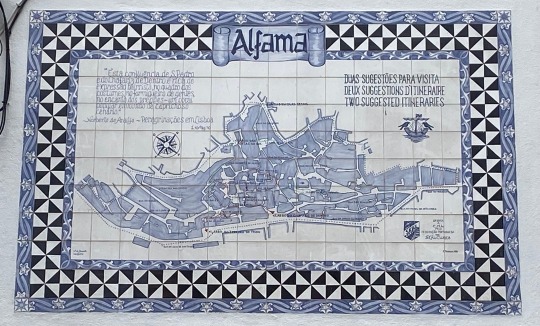
The roads are small and twisty and many of the roads cannot be transversed by even the smallest vehicle.

The place is built into hills - so steps are everywhere. (That is our sweet leader, Carolina. That is Car-o-leena. FYI.)

These houses were built in the 1500s. Many are covered with tile for easy maintenance.
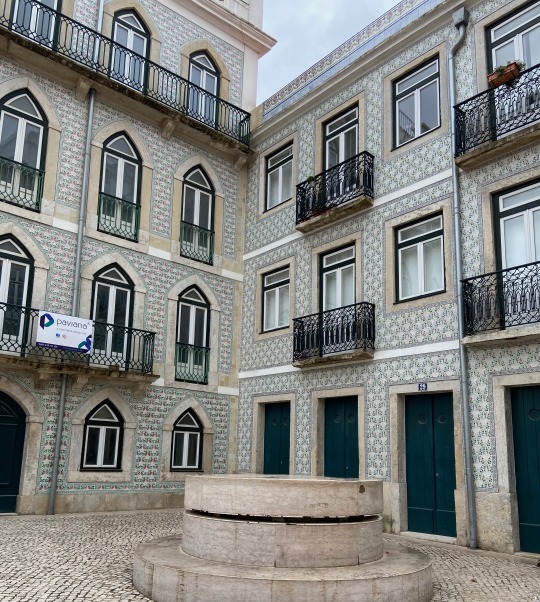
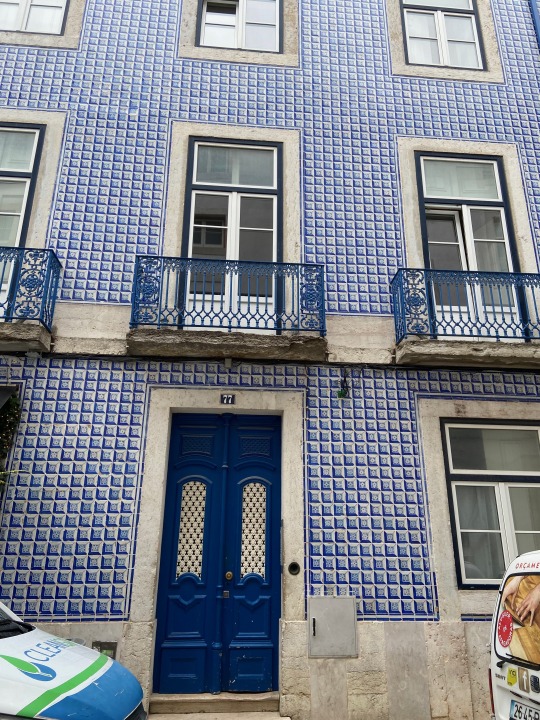
St Anthony is the patron saint of Lisboa and he was born in the Alfama. This cathedral was built on his birth place.
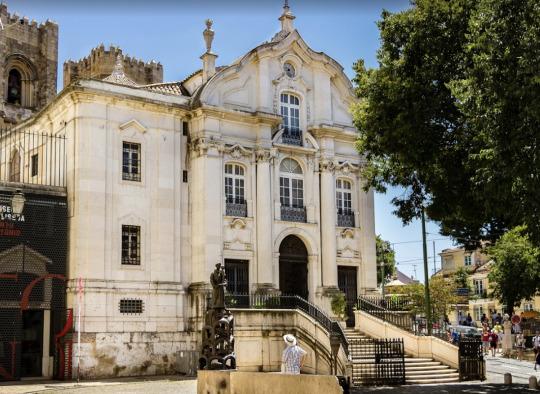

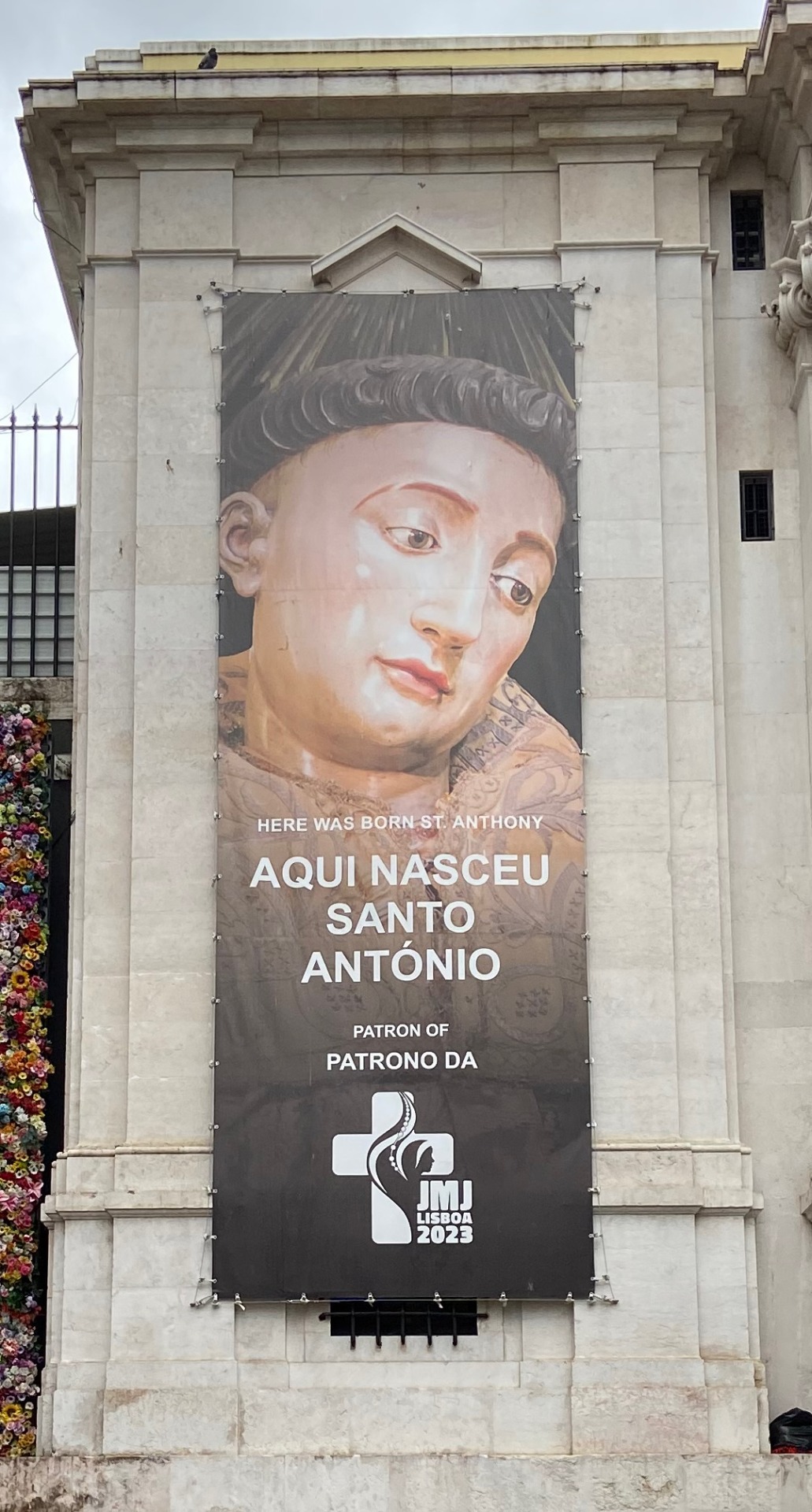
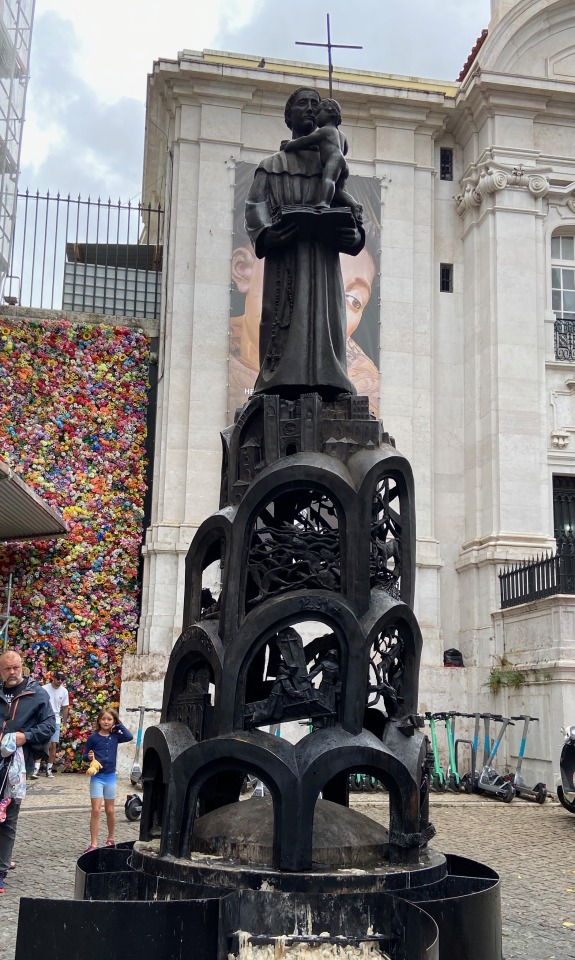
So the buzz on St. Anthony is that he is the patron saint of match making. Women hoping to find the man or their dreams come here and light a candle. Also he is the patron saint of "missing items". Can't find the car keys? Light a candle and ta-da!
To get to St. Anthony's just grab a trolley.

Shortly after our St. Anthony experience we stopped for coffee and an egg custard tart - Pastéis De Nata - THE Portuguese treat.

And - I can eat these. YUMMY!!!
Our walk eventually took us to the main square of the city - the square where the palace of the king and queen USED to be before it was destroyed by the tsunami in 1755. The new palace was built far from the sea after that event.
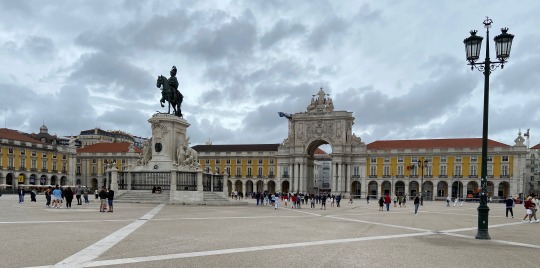
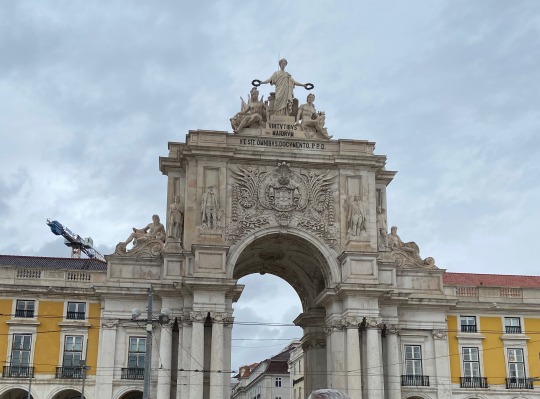
We continued exploring in the rain and saw the elevator
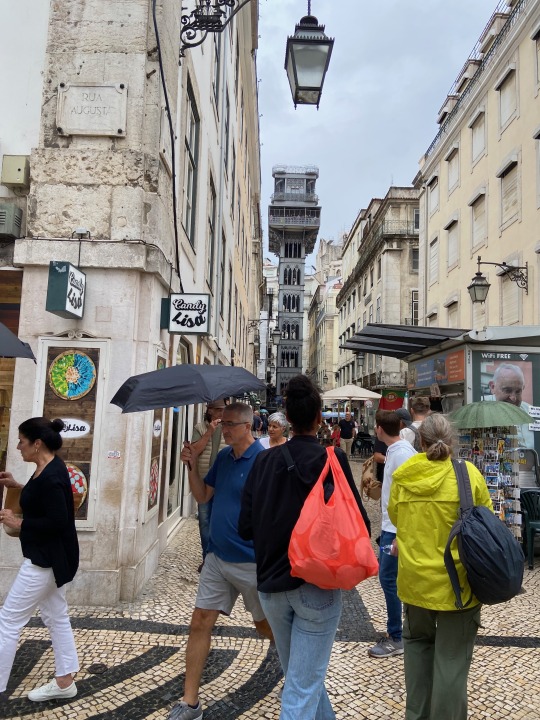
We kept walking and got to the main square of the city - the end of the line from the traffic circle from Marquis de Pombol. Check out the patterns in the circle. It is an optical illusion - because it is flat. Weird!

Some our group headed back to the hotel and some of us stayed on to enjoy - a local favorite - Bifanas (pork belly on a bun with mustard.) I couldn't have the bun - but the pork belly was yummy!
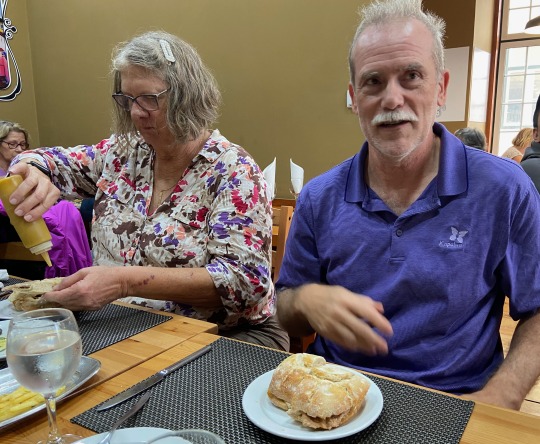
As we walked to the Metro we saw this...
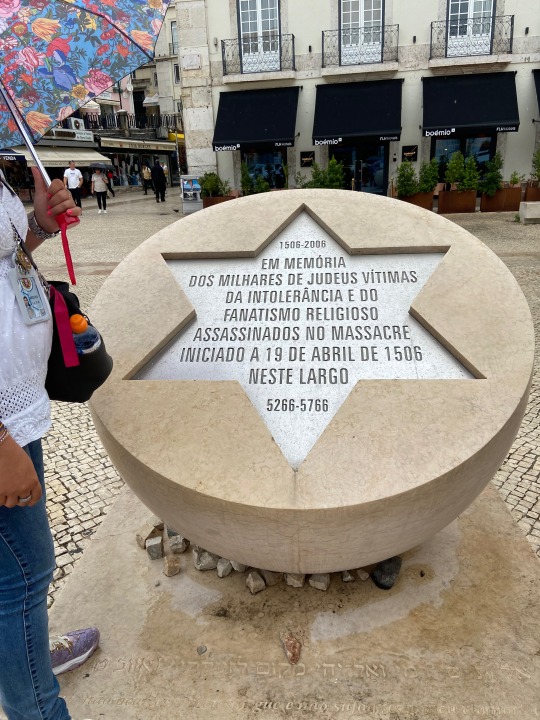
Carolina explained to us that this atrocity was a recent find in the hidden history of Lisbon. In 1506 in the middle of the Portuguese Inquisition a congregation of this church...
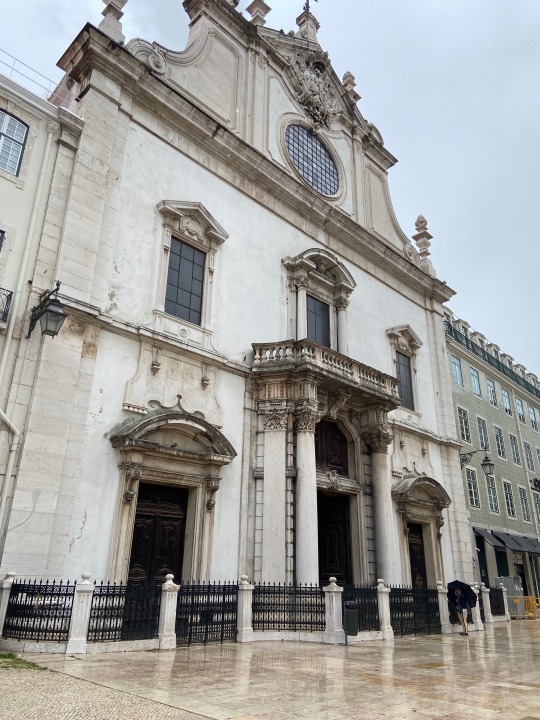
...mainly made up of "new" Christians - former Jews who had converted rather than die or be expelled - experience a "miracle." The alter was suddenly illuminated and the priest fell to his knees overcome by this miracle, but a parishioner said - HEY - WAIT - that is only the sunlight coming through that window. The priest was enraged and demanded that this "doubter" be killed - there and now. He was - and then the "real" Christians fell on the "new" Christians and killed them too. Then it was buried deep in the history books to be found quite by accident 500 years later.
Now, this church, has a series of bad events. Fire and other things have haunted this place for 600 years. Karma? Whatever it is, it has never had the same power as it experienced before 1500. To quote my granddaughter. when we are discussing history- or new jewelry, "I'm intrigued!"
From here we took the Metro to our hotel. PERFECT. Many people did many different things - but I took a nap. Only 40 minutes - but just the right amount of time to re-charge for dinner.
We took a lovely walk down the Avenue da Liberdade until we reached the funicular. The weather was perfect!!! We had some" technical difficulties" so we waited, waited, and waited but finally - we were headed up. We arrived at the overlook that Mark and I had visited yesterday. We felt so superior knowing exactly where were were...


At the top of the funicular we had a wonderful surprise from Carolina...
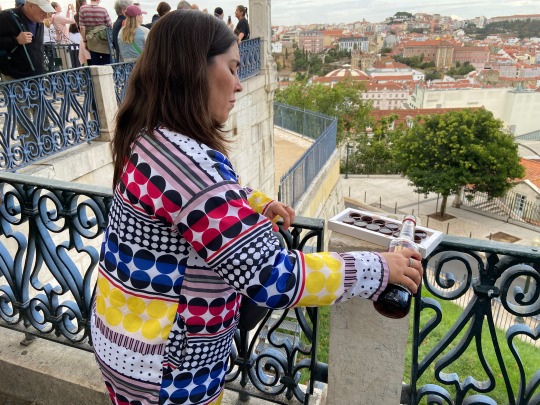

A cherry liquor served in chocolate cups. SWEET!!!!! Then on to our Welcome Dinner.
We had a wonderful dinner and a Fado performance. Fado is a Portuguese tradition and is a UNESCO intangible culture designation.
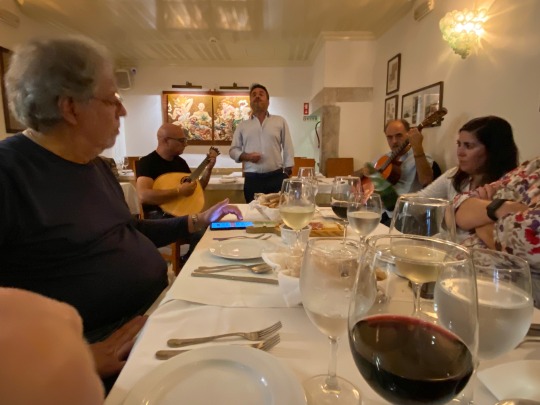

It was so much fun!!!
Check this out - (these are not the artists we saw - but it gives you a good understanding of this art.)
youtube
Tomorrow we will explore the city of Sintra. New discoveries await. I love my life!!!!
Stay tuned.
2 notes
·
View notes
Text
Holidays 6.13
Holidays
Aethra Asteroid Day
Beyond the Solar System Day
City Day (Lisbon, Portugal)
Dia de Exu (Brazil)
Flag Day (Palau)
International Albinism Awareness Day (UN)
International Axe Throwing Day
International Community Association Managers Day
Inventors’ Day (Hungary)
Jason Voorhees Day
Kitchen Klutzes of America Day
LGBTQIA Equal Pay Awareness Day
Loeys-Dietz Day of Giving
Michael Jackson Vindication Day
Military Gendarmerie Day (Poland)
Miranda Day
National Albinism Awareness Day
National Chamoy Day
National Dance/Movement Therapy Advocacy Day
National Day of Abortion Storytelling Day
National Day of Productive Business Civility
National Doe B Day
National Elderflower Day
National Frances Day
National Golf Cart Day
National Jane Day
National Pigeon Day
National Productive Business Civility Day
National Random Acts of Light Day
National Weed Your Garden Day
Outdoor Marketing Day
Random Acts of Light Day
Roller Coaster Day
San Antonio Day (Ceuta, Spain)
Sewing Machine Day
613 Day (Ottawa)
613 Mitzvot Day
Suleimaniah City Fallen and Martyrs Day (Iraqi Kurdistan)
Swiftie Day
Tench Day (French Republic)
Weed Your Garden Day
The Wicket World of Croquet Day
World Softball Day
Yawn-a-thon
Yeats Day
Food & Drink Celebrations
Cupcake Day (UK)
Cupcake Lover’s Day
National Cucumber Day
Rosé Day [also 2nd Saturday]
Independence & Related Days
Princian Commonwealth (Declared; 2017) [unrecognized]
Reform Movement Anniversary Day (Yemen)
2nd Thursday in June
National Career Nursing Assistants Day [2nd Thursday]
National Farm Workers Day [2nd Thursday]
Superman Celebration begins (Metropolis, Illinois) [2nd Thursday thru Sunday]
Throwback Thursday [Every Thursday]
World Judicial Officer Day [2nd Thursday]
Weekly Holidays beginning June 13 (2nd Full Week)
National Hermit Week (thru 6.20)
National Nursing Assistants Week (thru 6.19)
Festivals Beginning June 13, 2024
BBQ RibFest (Fort Wayne, Indiana) [thru 6.16]
Bonnaroo Music + Arts Festival (Manchester, Tennessee) [thru 6.16]
Chisholm Trail Roundup BBQ & Chili Cook-Offs (Lockhart, Texas) [thru 6.15
Chorus Inside International (Lloret de Mar, Spain) [thru 6.18]
Claw Down (Boothbay Harbor, Maine)
Gladbrook Corn Carnival (Gladbrook, Iowa) [thru 6.16]
Greenfield Festival (Interlaken, Switzerland) [thru 6.15]
Hollywood Fringe Festival (Los Angeles, California) [thru 6.30]
Indy Strawberry Festival (Indianapolis, Indiana) [thru 6.15]
Kirtland Kiwanis Strawberry Festival (Kirtland, Ohio) thru 6.15]
Lavender Bloom and Wine Event (Concho, Arizona) [thru 7.13]
Louisiana Corn Festival (Bunkie, Louisiana) [thru 6.15]
Newport Italianfest (Newport, Kentucky) [thru 6.16]
New York State Blues Festival (Syracuse, New York) [thru 6.15]
Ottawa Fringe Festival (Ottawa, Canada) [thru 6.23]
Owego Strawberry Festival (Owego, New York) [thru 6.15]
Sónar (Barcelona, Spain) [thru 6.15]
Springfield Fair (Springfield, Maine) [thru 6.16]
Taste of the Vineyard (Edgartown, Massachusetts) [thru 6.15]
Telluride Food + Vine (Telluride, Colorado) [thru 6.16]
Tour of America's Dairyland (Muliple locations, Wisconsin) [thru 6.23]
US Open Golf Championship (thru 6.16)
Feast Days
Annie Sprinkle Day (Church of the SubGenius; Saint)
Anthony of Padua, Doctor of the Church (Christian; Saint) [Portugal]
Aquilina (Christian; Saint)
Audrey Niffenegger (Writerism)
Balor (Celtic Book of Days)
Bricket Wood Day (Starza Pagan Book of Days)
Buddha's Parinirvana (Bhutan)
Cetteus (Peregrinus; Christian; Saint)
Damhnade of Ireland (Christian; Saint)
Day of the Living Children of Nut (Ancient Egypt)
Dorothy L. Sayers(Writerism)
Feast of Epona (Celtic; Pagan)
Felicula (Christian; Saint)
Festival of Jupiter Invictus (Jupiter the Unconquered)
First-in-Line and Queue-Jumping Tournament (Shamanism)
G. K. Chesterton (Episcopal Church (USA))
Gerard of Clairvaux (Christian; Saint)
Gin Day (Pastafarian)
Gotthard Graubner (Artology)
Green Day (Pastafarian)
Ides of June (Ancient Rome)
Leon Chwistek (Artology)
Psalmodius (Christian; Saint)
Quinquatrus Minusculae (Old Roman Festival to Minerva)
Ragnebert (a.k.a. Rambert; Christian; Saint)
Ralph McQuarrie (Artology)
The Spaniel (Muppetism)
St. Theresa (Positivist; Saint)
Thomas Woodhouse (Christian; Blessed)
Triphyllius (Christian; Saint)
William Butler Yeats (Writerism)
Hebrew Calendar Holidays [Begins at Sundown Day Before]
Shavuot ends (Judaism) [7 Sivan] (a.k.a. …
Feast of the Harvest
Feast of Weeks
Festival of Weeks
First-Fruit festival
Wheat Harvest
Lucky & Unlucky Days
Shakku (赤口 Japan) [Bad luck all day, except at noon.]
Water Husband Name Day (Young Women fill their mouth with water and didn’t let it out until they heard a man’s name. That name would be the name of their future husband; Portugal)
Premieres
The Apocalypse Watch, by Robert Ludlum (Novel; 1995)
Back to School (Film; 1986)
Backwoods Bunny (WB LT Cartoon; 1959)
BrainDead (TV Series; 2016)
Cherche Le Phantom (The Inspector Cartoon; 1968)
Day of Infamy, by Walter Lord (History Book; 1957)
The Disillusioned Bluebird (Color Rhapsody Cartoon; 1944)
Faith and Courage, by Sinead O’Connor (Album; 2000)
Forever Your Girl, by Paula Abdul (Album; 1988)
The Game of Kings, by Dorothy Dunnett (Novel; 1961)
Hercules (Animated Disney Film; 1997)
Horsefly Opera (Terrytoons Cartoon; 1941)
How to Train Your Dragon 2 (Animated Film; 2014)
I’ll Be Skiing Ya (Fleischer/Famous Popeye Cartoon; 1947)
The Incredible Hulk (Film; 2008)
Jagged Little Pill, by Alan’s Morrisette (Album; 1995)
Jet Pink (Pink Panther Cartoon; 1967)
Kind Hearts and Coronets (Film; 1949)
Les Noces, by Igor Stravinsky (Ballet; 1923)
Lolita (Film; 1962)
Make It With You, by Bread (Song; 1970)
Mona Lisa (Film; 1986)
Nine Princes in Amber, by Roger Zelazny (Novel; 1970)
Olive’s Boithday Presink (Fleischer Popeye Cartoon; 1941)
The Omen, by David Seltzer (Novel; 1976)
Pat and Mike (Film; 1952)
Petrushka, by Igor Stravinsky (Ballet; 1911)
Post, by Björk (Album; 1995)
The Price of Salt, by Claire Morgan (Novel; 1952)
The Prince and the Showgirl (Film; 1957)
Prozac Nation (Film; 2003)
Roadie (Film; 1980)
Tales of the City, by Armistead Maupin (Serialized Novel; 1978)
Texas Flood, by Stevie Ray Vaughan (Album; 1983)
22 Jump Street (Film; 2014)
…Very ‘Eavy …Very ‘Umble, by Uriah Heel (Album; 1970)
Vida La Vida, by Coldplay (Song; 2008)
The Washout Chronicle, by John Cheever (Novel; 1957)
Wholly Moses (Film; 1980)
The World is Flat, by Thomas L. Friedman (Economics Book; 2005)
Yodeling Yokels (WB LT Cartoon; 1931)
You Only Live Twice (US Film; 1967) [James Bond #5]
Today’s Name Days
Antonius, Bernhard (Austria)
Antonija, Antun, Toni (Croatia)
Antonín (Czech Republic)
Cyrillus (Denmark)
Monika, Mooni, Moonika (Estonia)
Raila, Raili (Finland)
Antoine (France)
Anton, Antonius, Bernhard (Germany)
Trifilios (Greece)
Anett, Antal (Hungary)
Alice, Antonio (Italy)
Ainārs, Tautvaldis, Tobijs, Uva, Zigfrīds, Zigrids (Latvia)
Akvilina, Antanas, Kunotas, Skalvė (Lithuania)
Tanja, Tone, Tonje (Norway)
Antoni, Chociemir, Herman, Lucjan, Maria Magdalena, Tobiasz (Poland)
Achilina (România)
Anton (Slovakia)
Antonio (Spain)
Aina, Aino (Sweden)
Kalyna (Ukraine)
Ivey, Ivy, Lara, Larissa (USA)
Today is Also…
Day of Year: Day 165 of 2024; 201 days remaining in the year
ISO: Day 4 of week 24 of 2024
Celtic Tree Calendar: Duir (Oak) [Day 5 of 28]
Chinese: Month 5 (Geng-Wu), Day 8 (Wu-Shen)
Chinese Year of the: Dragon 4722 (until January 29, 2025) [Wu-Chen]
Hebrew: 7 Sivan 5784
Islamic: 6 Dhu al-Hijjah 1445
J Cal: 15 Blue; Oneday [15 of 30]
Julian: 31 May 2024
Moon: 50%: 1st Quarter
Positivist: 24 St. Paul (6th Month) [St. Theresa]
Runic Half Month: Dag (Day) [Day 5 of 15]
Season: Spring (Day 87 of 92)
Week: 2nd Full Week of June)
Zodiac: Gemini (Day 24 of 31)
0 notes
Text
Holidays 6.13
Holidays
Aethra Asteroid Day
Beyond the Solar System Day
City Day (Lisbon, Portugal)
Dia de Exu (Brazil)
Flag Day (Palau)
International Albinism Awareness Day (UN)
International Axe Throwing Day
International Community Association Managers Day
Inventors’ Day (Hungary)
Jason Voorhees Day
Kitchen Klutzes of America Day
LGBTQIA Equal Pay Awareness Day
Loeys-Dietz Day of Giving
Michael Jackson Vindication Day
Military Gendarmerie Day (Poland)
Miranda Day
National Albinism Awareness Day
National Chamoy Day
National Dance/Movement Therapy Advocacy Day
National Day of Abortion Storytelling Day
National Day of Productive Business Civility
National Doe B Day
National Elderflower Day
National Frances Day
National Golf Cart Day
National Jane Day
National Pigeon Day
National Productive Business Civility Day
National Random Acts of Light Day
National Weed Your Garden Day
Outdoor Marketing Day
Random Acts of Light Day
Roller Coaster Day
San Antonio Day (Ceuta, Spain)
Sewing Machine Day
613 Day (Ottawa)
613 Mitzvot Day
Suleimaniah City Fallen and Martyrs Day (Iraqi Kurdistan)
Swiftie Day
Tench Day (French Republic)
Weed Your Garden Day
The Wicket World of Croquet Day
World Softball Day
Yawn-a-thon
Yeats Day
Food & Drink Celebrations
Cupcake Day (UK)
Cupcake Lover’s Day
National Cucumber Day
Rosé Day [also 2nd Saturday]
Independence & Related Days
Princian Commonwealth (Declared; 2017) [unrecognized]
Reform Movement Anniversary Day (Yemen)
2nd Thursday in June
National Career Nursing Assistants Day [2nd Thursday]
National Farm Workers Day [2nd Thursday]
Superman Celebration begins (Metropolis, Illinois) [2nd Thursday thru Sunday]
Throwback Thursday [Every Thursday]
World Judicial Officer Day [2nd Thursday]
Weekly Holidays beginning June 13 (2nd Full Week)
National Hermit Week (thru 6.20)
National Nursing Assistants Week (thru 6.19)
Festivals Beginning June 13, 2024
BBQ RibFest (Fort Wayne, Indiana) [thru 6.16]
Bonnaroo Music + Arts Festival (Manchester, Tennessee) [thru 6.16]
Chisholm Trail Roundup BBQ & Chili Cook-Offs (Lockhart, Texas) [thru 6.15
Chorus Inside International (Lloret de Mar, Spain) [thru 6.18]
Claw Down (Boothbay Harbor, Maine)
Gladbrook Corn Carnival (Gladbrook, Iowa) [thru 6.16]
Greenfield Festival (Interlaken, Switzerland) [thru 6.15]
Hollywood Fringe Festival (Los Angeles, California) [thru 6.30]
Indy Strawberry Festival (Indianapolis, Indiana) [thru 6.15]
Kirtland Kiwanis Strawberry Festival (Kirtland, Ohio) thru 6.15]
Lavender Bloom and Wine Event (Concho, Arizona) [thru 7.13]
Louisiana Corn Festival (Bunkie, Louisiana) [thru 6.15]
Newport Italianfest (Newport, Kentucky) [thru 6.16]
New York State Blues Festival (Syracuse, New York) [thru 6.15]
Ottawa Fringe Festival (Ottawa, Canada) [thru 6.23]
Owego Strawberry Festival (Owego, New York) [thru 6.15]
Sónar (Barcelona, Spain) [thru 6.15]
Springfield Fair (Springfield, Maine) [thru 6.16]
Taste of the Vineyard (Edgartown, Massachusetts) [thru 6.15]
Telluride Food + Vine (Telluride, Colorado) [thru 6.16]
Tour of America's Dairyland (Muliple locations, Wisconsin) [thru 6.23]
US Open Golf Championship (thru 6.16)
Feast Days
Annie Sprinkle Day (Church of the SubGenius; Saint)
Anthony of Padua, Doctor of the Church (Christian; Saint) [Portugal]
Aquilina (Christian; Saint)
Audrey Niffenegger (Writerism)
Balor (Celtic Book of Days)
Bricket Wood Day (Starza Pagan Book of Days)
Buddha's Parinirvana (Bhutan)
Cetteus (Peregrinus; Christian; Saint)
Damhnade of Ireland (Christian; Saint)
Day of the Living Children of Nut (Ancient Egypt)
Dorothy L. Sayers(Writerism)
Feast of Epona (Celtic; Pagan)
Felicula (Christian; Saint)
Festival of Jupiter Invictus (Jupiter the Unconquered)
First-in-Line and Queue-Jumping Tournament (Shamanism)
G. K. Chesterton (Episcopal Church (USA))
Gerard of Clairvaux (Christian; Saint)
Gin Day (Pastafarian)
Gotthard Graubner (Artology)
Green Day (Pastafarian)
Ides of June (Ancient Rome)
Leon Chwistek (Artology)
Psalmodius (Christian; Saint)
Quinquatrus Minusculae (Old Roman Festival to Minerva)
Ragnebert (a.k.a. Rambert; Christian; Saint)
Ralph McQuarrie (Artology)
The Spaniel (Muppetism)
St. Theresa (Positivist; Saint)
Thomas Woodhouse (Christian; Blessed)
Triphyllius (Christian; Saint)
William Butler Yeats (Writerism)
Hebrew Calendar Holidays [Begins at Sundown Day Before]
Shavuot ends (Judaism) [7 Sivan] (a.k.a. …
Feast of the Harvest
Feast of Weeks
Festival of Weeks
First-Fruit festival
Wheat Harvest
Lucky & Unlucky Days
Shakku (赤口 Japan) [Bad luck all day, except at noon.]
Water Husband Name Day (Young Women fill their mouth with water and didn’t let it out until they heard a man’s name. That name would be the name of their future husband; Portugal)
Premieres
The Apocalypse Watch, by Robert Ludlum (Novel; 1995)
Back to School (Film; 1986)
Backwoods Bunny (WB LT Cartoon; 1959)
BrainDead (TV Series; 2016)
Cherche Le Phantom (The Inspector Cartoon; 1968)
Day of Infamy, by Walter Lord (History Book; 1957)
The Disillusioned Bluebird (Color Rhapsody Cartoon; 1944)
Faith and Courage, by Sinead O’Connor (Album; 2000)
Forever Your Girl, by Paula Abdul (Album; 1988)
The Game of Kings, by Dorothy Dunnett (Novel; 1961)
Hercules (Animated Disney Film; 1997)
Horsefly Opera (Terrytoons Cartoon; 1941)
How to Train Your Dragon 2 (Animated Film; 2014)
I’ll Be Skiing Ya (Fleischer/Famous Popeye Cartoon; 1947)
The Incredible Hulk (Film; 2008)
Jagged Little Pill, by Alan’s Morrisette (Album; 1995)
Jet Pink (Pink Panther Cartoon; 1967)
Kind Hearts and Coronets (Film; 1949)
Les Noces, by Igor Stravinsky (Ballet; 1923)
Lolita (Film; 1962)
Make It With You, by Bread (Song; 1970)
Mona Lisa (Film; 1986)
Nine Princes in Amber, by Roger Zelazny (Novel; 1970)
Olive’s Boithday Presink (Fleischer Popeye Cartoon; 1941)
The Omen, by David Seltzer (Novel; 1976)
Pat and Mike (Film; 1952)
Petrushka, by Igor Stravinsky (Ballet; 1911)
Post, by Björk (Album; 1995)
The Price of Salt, by Claire Morgan (Novel; 1952)
The Prince and the Showgirl (Film; 1957)
Prozac Nation (Film; 2003)
Roadie (Film; 1980)
Tales of the City, by Armistead Maupin (Serialized Novel; 1978)
Texas Flood, by Stevie Ray Vaughan (Album; 1983)
22 Jump Street (Film; 2014)
…Very ‘Eavy …Very ‘Umble, by Uriah Heel (Album; 1970)
Vida La Vida, by Coldplay (Song; 2008)
The Washout Chronicle, by John Cheever (Novel; 1957)
Wholly Moses (Film; 1980)
The World is Flat, by Thomas L. Friedman (Economics Book; 2005)
Yodeling Yokels (WB LT Cartoon; 1931)
You Only Live Twice (US Film; 1967) [James Bond #5]
Today’s Name Days
Antonius, Bernhard (Austria)
Antonija, Antun, Toni (Croatia)
Antonín (Czech Republic)
Cyrillus (Denmark)
Monika, Mooni, Moonika (Estonia)
Raila, Raili (Finland)
Antoine (France)
Anton, Antonius, Bernhard (Germany)
Trifilios (Greece)
Anett, Antal (Hungary)
Alice, Antonio (Italy)
Ainārs, Tautvaldis, Tobijs, Uva, Zigfrīds, Zigrids (Latvia)
Akvilina, Antanas, Kunotas, Skalvė (Lithuania)
Tanja, Tone, Tonje (Norway)
Antoni, Chociemir, Herman, Lucjan, Maria Magdalena, Tobiasz (Poland)
Achilina (România)
Anton (Slovakia)
Antonio (Spain)
Aina, Aino (Sweden)
Kalyna (Ukraine)
Ivey, Ivy, Lara, Larissa (USA)
Today is Also…
Day of Year: Day 165 of 2024; 201 days remaining in the year
ISO: Day 4 of week 24 of 2024
Celtic Tree Calendar: Duir (Oak) [Day 5 of 28]
Chinese: Month 5 (Geng-Wu), Day 8 (Wu-Shen)
Chinese Year of the: Dragon 4722 (until January 29, 2025) [Wu-Chen]
Hebrew: 7 Sivan 5784
Islamic: 6 Dhu al-Hijjah 1445
J Cal: 15 Blue; Oneday [15 of 30]
Julian: 31 May 2024
Moon: 50%: 1st Quarter
Positivist: 24 St. Paul (6th Month) [St. Theresa]
Runic Half Month: Dag (Day) [Day 5 of 15]
Season: Spring (Day 87 of 92)
Week: 2nd Full Week of June)
Zodiac: Gemini (Day 24 of 31)
0 notes
Text
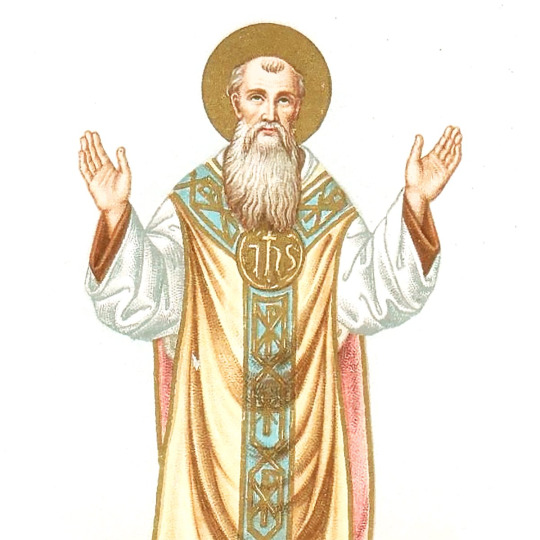
THE DESCRIPTION OF SAINT LAWRENCE OF BRINDISI Feast Day: July 21
"Nos cum prole pia, benedicat Virgo Maria." (Mary, with Her loving Son, bless us each and every one.)
One of the greatest preachers of the Order of Friars Minor Capuchin, Lawrence was born Giulio Cesare Russo, on the feast of St. Mary Magdalene - Brindisi, a city located in the Apulia region at Kingdom of Naples in the year 1559. Showing an early gift for oratory, he was always the one chosen to address, in accordance with the Italian custom, a short sermon to his compatriots on the Infant Jesus during the Christmas festivities. He is raised by a family of Venetian merchants. At the age of 16, he entered the Capuchin Franciscans in Venice, receiving the habit, and changed his name from Cesare to Lawrence.
An accomplished linguist, in addition to his native Italian, Lawrence could read and speak Latin, Hebrew, Greek, German, Bohemian, Spanish, and French fluently. While still a deacon he preached the Lenten sermons in Venice. After his ordination at the age of 23, he became famous throughout Europe as a forceful preacher. He also wrote many theological books and worked for the conversion of the Jews. Lawrence was elected superior of the Capuchin Franciscan province of Tuscany at the age of 31, and appointed definitor general in Rome for the Capuchins in 1596.
Pope Clement VIII assigned him the task of preaching to the Jews in the city. His knowledge of the Hebrew language was of great help in this regard. Beginning in 1599, Lawrence was sent to establish the Capuchin convents in modern Germany and Austria as a barrier agent in Lutheranism, furthering the Counter-Reformation and bringing many Protestants back to the Catholic faith. He also founded friaries in Vienna, Prague, and Graz.
On account of of his holiness, he was named the imperial chaplain of the Christian forces sent by Rudolph II (Rudolf II), Holy Roman Emperor, and successfully recruited Philippe Emmanuel, Duke of Mercœur, against the Ottoman Turks, who were threatening Hungary. Before the Siege of Székesfehérvár (Stuhlweissenburg) in 1601, though the Christians were outnumbered four to one, he gave a rousing address to the troops. Then he himself rode a horse before them, armed with the crucifix in his hand. The Turks were defeated and Europe was saved.
At their chapter of 1602, Lawrence was elected vicar general of the Capuchin friar, at that time the Order's highest office, whom he administered with energy and charity. Despite his fervent apostolate, Lawrence was a man of prayer and learning. He entered the service of the Holy See, becoming papal nuncio to Bavaria. After serving as nuncio to Spain, he retired to a monastery in 1618, and was recalled as a special envoy to the King of Spain regarding the actions of the Viceroy of Naples in 1619, and after finishing his mission, died in Lisbon, Portugal on July 22, 1619 - his 60th birthday.
Beatified by Pope Pius VI on June 1, 1783 and canonized a saint by Pope Leo XIII on the feast of the Immaculate Conception in 1881, Lawrence's remains were entombed at the Poor Clares' Convento de la Anunciada (Convent of the Annunciation) in Villafranca del Bierzo, Spain. Because of his creative yet orthodox writings on the Virgin Mary and for his commanding erudition in, and harmonious presentation of, Scripture, patristics, and fundamental theology, Pope St. John XXIII proclaimed him a Doctor of the Church in 1959.
Lawrence of Brindisi is the third Franciscan Doctor of the Church, along with Saints Bonaventure and Anthony of Padua, and, unfortunately, one of the least well-known.
1 note
·
View note
Text






The "Sermon of Saint Anthony to the Fish" (Portuguese: Sermão de Santo António aos Peixes) is a sermon written by Portuguese Jesuit priest António Vieira, preached to the congregation at the Church of Saint Anthony in São Luís do Maranhão, Colonial Brazil, on 13 June 1654.[1] It is Vieira's most famous work.
It was preached in the context of the conflict between the colony's settlers and the Jesuits, who reiterated Pope Urban VIII's prohibition against Indian slavery.[2] Three days after preaching it, Vieira secretly embarked to Lisbon to appeal King John IV for laws that would guarantee basic rights to Brazilian Indians, preventing them from being exploited by white colonists.
The sermon comprises an elaborate allegory: borrowing from the familiar legend of his namesake Saint Anthony's preaching to the fish (commonly cited in his hagiography), Vieira uses the different kinds of fish as metaphors for men, drawing direct parallels between the dynamics between big and little fish and those between colonists and the Indians
Saint Anthony's hagiography includes the legendary episode of the Sermon of the Fishes: while preaching to the heretics at Rimini who derided him, the saint turned instead to the seashore and began to preach to the fishes on their predatory nature; the fishes miraculously came at his call, and remained with their heads out of the water until he had finished speaking and gave them his blessing.[5] Instead of, as expected, commenting on the saint's apostolic virtue having the day's Gospel as a starting point, Vieira instead satirised his disenchantment with the colonists and their vices by making allusions to their faults in the characteristics of different types of fish, in a direct imitation of Saint Anthony: "But for many days now it has been in my thoughts that, on the feast days of the Saints, it is better to preach like them than to preach about them. All the more so since the salt of my doctrine, whatever it is, has had in this city a fortune so similar to that of Saint Anthony in Rimini that it is necessary to follow him in everything."[6]
0 notes
Text
Novena to Saint Anthony
🌻🌻🌻🌻🌻🌻🌻🌻🌻🌻
#Day3:
[Franciscan, Missionary and Martyr]
Saint Anthony went to Morocco.
“courageously determined to experience the Gospel in the footsteps of the Franciscan friars who had been martyred there.”
(Pope Francis, Feb 15, 2020)
When the Infant Pedro brought back the relics of the five martyred Friars Minor from Marrakech, claiming to have been miraculously freed by their merits, Fernando, struck by this news, believed it was his duty to leave his monastery, in order to obtain like them the palm of martyrdom, and decided to put on their habit and follow their radical way of life.
There were friars of this Order who lived in the hermitage of St Anthony the Abbot of Olivet, near Coimbra, and who came to Anthony’s monastery to ask for alms.
One day, unable to restrain himself, Fernando took them aside, and revealed his project to them.
Delighted, the brothers set a meeting time, and, in that same monastery, clothed him with the habit of their Order.
Fernando changed his name to Anthony, and went without delay to the land of the Saracens (2,7).
However God had a different plan for him.
Stricken by a serious illness, he set out to return to Portugal, but instead a storm at sea and strong winds pushed the boat off the coast of Sicily and Anthony’s dream of becoming a martyr crumbled.
(Assidua, 5:1; Vita secunda, 1:12. 2:8-10)
In the name of the Father and of the Son and of the Holy Spirit.
Let us pray that God will give us the same strength of faith and martyr’s courage that animated Saint Anthony of Padua.
[His spiritual journey]
In 2020, the cities of Padua, Coimbra and Lisbon celebrated with a Jubilee year the 800th anniversary of St Anthony's Franciscan vocation.
The witness of the first Franciscan martyrs produced a 180° turn in Anthony’s quiet life as an Augustinian canon.
All his biographers agree on this point: Anthony was suddenly seized by an extraordinary fervor.
He wanted to repair the insults done to Christ, the deaths of the martyrs, and resist a politico-religious power that knew only violence and denied human dignity.
The simple life of the Franciscan Brothers, living on almsgiving and with no fixed abode, wholly dedicated to the proclamation of the Gospel, was in sharp contrast with his Augustinian abbey that was enjoying the subsidies of the king, who had chosen it for his burial place.
At the age of 25, according to traditional chronology, an enthusiastic Anthony decided to leave the Canons Regular for the habit and life of the Brothers who had died for Christ.
He made this decision without regrets: since "he had already been frustrated once in his desire by the Divine Will, he no longer had the presumption to attempt a new undertaking, and henceforth he relied totally on the good will of God...
God kept him for greater undertakings."
(Vita secunda, 3,11)
[Thoughts]
"Blessed is he whom the sword of the wicked has not frightened, but transformed into a better person."
(Julian of Speyer, Liturgical Office)
"Anthony, martyr of desire, you ardently sought to share in the death of the martyrs!
While the sword of the persecutor did not end your life, your soul did not lose the palm of martyrdom."
(Rigaldina, 4,8)
"Saint Anthony, struck by the Franciscan way of embracing and living the Gospel, rose from among us, passed through our human city and traced for us in an exemplary way the paths of wisdom that would lead to salvation."
(Don Virgilio do Nascimento Antunes, Bishop of Coimbra, June 13, 2020, Saint Anthony dos Olivais)
In Anthony’s Sermons, the word "martyr" comes up 29 times, in reference to John the Apostle, the Blessed Virgin, and the Apostles Peter and Paul, to evoke the harshness of suffering and death and to underline the seeds of life for the martyrs themselves and for the Church.
"Saint John did not die a martyr’s death, but was nevertheless a martyr: he was plunged into a barrel of boiling oil, sent into exile in Patmos, and forced to swallow poison."
(St Anthony, Feast of St John the Evangelist)
"The 12 stars (Rev 12:1) were Mary's 12 glorious merits in Heaven, in her flesh and in her heart.
The glorious merits of her heart were humble devotion, reserved modesty, great faith and martyrdom of the heart, for "a sword pierced her soul"
(Lk 1:31).
(St Anthony, Annunciation of the Virgin Mary II)
Every martyrdom is the seed of conversion.
By the shedding of their blood, the martyrs watered souls in the garden of the Church, so that she might persevere in the greenness, strength and vigor of the faith.
(St Anthony, Feast of Saints Peter and Paul)
The Passion of Christ is called "excess," since it exceeded the pain and passion of all the martyrs put together and exceeded any other passion.
(St Anthony, First Sunday after Christmas)
"They offered sacrifices of justice."
By their martyrdom, Peter and Paul sacrificed their righteous and holy bodies to the Lord as victims of justice.
(St Anthony, Feast of Saints Peter and Paul)
"They will suck the floods of the sea like milk."
An overflowing sea is frightening in appearance and bitter in taste; milk, on the other hand, has a pleasant color and a sweet flavor.
To suck means to desire with avidity and to taste with pleasure.
"O love of Christ, who makes all bitter things sweet!
The martyrdom of the Apostles was frightening and bitter, but the love of Christ changed it into sweetness.
They received Him with avidity and pleasure, and then received happiness with Him for eternity."
(St Anthony, Feast of Saints Peter and Paul)
[Meditation]
"Let each one glory in his own martyrdom"...
Anthony's aspiration to martyrdom was part of the very spirit of the Order of Friars Minor.
To those who glorified the martyrdom of the Friars of Morocco, Francis replied that dying a martyr's death was everyone's calling, and he himself gave the example, undertaking three times the journey to the Holy Land and among the infidels.
As Thomas de Celano, his biographer, wrote, "he had an ardent desire for martyrdom."
"The ardor of charity," added St Bonaventure, "impelled him to imitate the glory of the holy martyrs, for nothing could extinguish the flame of their love or weaken their fortitude."
There are two kinds of martyrs, both equally demanding in their self-giving and eloquent in their witness to Christ who offered himself to his Father on the Cross: the violent death or "martyrdom of blood," and the offering of one's own life as a spiritual sacrifice pleasing to God, just as Christ offered himself to his Father on the Cross.
Thus, Saint Francis identified himself with Christ to the point of dying naked on the naked earth, and Anthony, in the vision and joy of his Lord.
(Assidua 17,12)
This kind of death can be ours too.
We are not asked to expose our bodies to persecutors, even though many Christians are still persecuted and violently martyred today, but to offer our work, prayers, our daily occupations, acts of kindness and assistance towards our suffering brothers and sisters, our illnesses and all the inconveniences of life, in immolation and holocaust.
By immolation we become victims and sacrifice; by burnt offering, "we burn on the altar of the Lord as a sweet incense pleasing to the Lord."
(St Anthony)
[Prayer]
"Saint Anthony, you invite us to discover the price of our lives and measure the depth of our wounds by the Cross of Christ that only the Blood of the Son of God can heal.
Help us to understand with what love we are loved and to offer our sufferings for the salvation of the world. Amen."
(Saint Anthony Novena – Grottos of Brive)
Saint Anthony, we entrust to you the sick, the unemployed, our struggles to meet the needs of our family and children, those who are exposed to heavy work, poor health and unsafe conditions, those injured at work, occupational and road accidents, and all the small and large crosses of our daily life.
Give us the grace to carry all those crosses with love, following your example, and with the help of Jesus.
© Marie de Nazareth 2023
Association Marie de Nazareth 75 rue de Lourmel 75015 Paris – France


0 notes
Text
What to do in Lisbon on a rainy day!
What to do in Lisbon on a rainy days I have to admit it - most destinations are best when it doesn't rain. Fortunately Lisbon is the city in Europe with most sunny days and lowest rainfall. So sunny, blue and warm days are the most common. But on rare occasions travelers find themselves caught in all day rain - and on very rare occasions several days in a row. Like these days where - all others than people living in Portugal (the country desperately needs the rain) will find the weather forecast for the next days depressing. What do you do in a City where one of the best thing to do is walking up and down the hills, looking at beautiful houses and buildings, sipping coffee and wine at one of Lisbon many Quiosques or just chilling in the sun by the Tejo river. In principles just go through all Lisbon Guides and pick the museums, palaces, churches, galleries and all other indoor options you prefer, combine them with serious eateries and pimp the program up with power-shopping in-between. But since its raining why not take advantage of the situation and spend the time you 'win' because of the limited outdoor possibilities to check out the more exotic possibilities Lisbon offers. Or and dwell longer time with things you really like instead of stressing around to check out all the must see Tourist sights. A lot of these places you do not understand why are interesting when you see them ... I have asked a few friends about what to recommend when we have all day rain in Lisbon. Enjoy Thomas A handfull of recommendations #1: Stay Underground - explore Lisbon's Metro Art The Picoas Metro station is one of the original eleven metro stations. The world's first underground railway in London used tiles to decorate the platforms of its stations. The Portuguese cultural tradition of azulejos tile panels is well represented in Lisbon's traditions and reflects the ornate decoration of the city's churches and mosaic-like calçada pavements. If you are interested in modern art or it is a rainy day take a trip around the Lisbon metro using a Lisboa Card, (which is also valid on Lisbon buses, trams and elevators) or a Viva Viagem card, to see some of the finest contemporary civic art and architecture in Europe. Portugal Visitor An Artguide to Lisbon's Metro #2: Spend a few hours with Hieronymus Bosch The Museu National de Art Antiga is Portugal's "national gallery". It opened in 1884 in a 17th-century palace with beautiful terraces with fantastic Tejo view. One more time - don't stress. Its still raining! So instead immerse yourself in MNAA's most significant works. Like these three master pieces: Hieronymus Bosch's: Temptation of Saint Anthony, Albrecht Dürer's: Saint Jerome and Nuno Gonçalves 15th century masterpiece: Panels of St. Vincent. Maybe the best Art Destination in Lisbon Museu National de Art Antiga A mapped guide to Padle Venues in Lisbon Deep Purple introduced me to Hieronymus Bosch. His The Garden of Earthly Delights was used as the bands 2nd album cover. That piece is in Prada in Madrid. BUT MNAA has Bosch's best work: Temptation of Saint Anthony.On a rainy day a week ago we took our friends there - we spend more than 1 hour on that piece alone! If you only are allowed to visit one museum - this is the MNAA! #3: Indoor Padle A Mapped guide til all Lisbon's Padel Venues Lisbon is a walking town. So prepare yourself for a lot of exercise. One of the problem on rainy days is that walking is limited - and so are the exercise. And due to the weather you probably eat more than usual. So if you need to move and burn calories why not enjoy a few hours of Indoor Paddling? Urban Sports Club A mapped guide to Padle Venues in Lisbon #4: Seek shelter in Casa do Alentejo The Palace is a difficult to explain. In the early twentieth century the Palace was leased to a company that transformed a part of it to Lisbon's first casino. Most travellers just pass by this anonymous Palace on the way to a popular tourist sight. But remember: its raining - so you have the time to chill around and enjoy the fantastic settings: the walls, panels, furniture, balconies, lamps... One of our favorite spots. Casa do Alentejo A hidden gem for a rainy day Casa do Alentejo doesn't look special from the outside. The Palace has a very spacious and beautiful Restaurant - but don't waste your good appetite there. #5: Take a round trip with tram #28 The famous #28 in Graça 2 min from our door. Instead of letting the rain stress you - take a roundtrip. OR even better: Take it to Mercado de Campo de Ourique and eat lunch (much better than the Time Out market) and take the tram back to Graça Tram #28 is on most people's bucket list. On most days the line of tourists waiting to get a seat so long that it can take an hour or longer to get in. Except for two occasions. At night time AND when it rains. Both occasions that make the trip on this popular tram something special. TogA's Travel Guide We love the tram #28 #6: Get tipsy from excellent portwines Located in a prestigious area within the historic district of Alfama, next to Chafariz del Rei, the first ever public fountain in Lisbon dating back to 1487, Taylor’s Port wine shop and tasting room showcases a wide range of our Ports and is the first of its kind in Lisbon. This recently opened space includes a shop on the ground floor and three tasting rooms on the first floor. There are 15 wines available to try in the tasting room, starting at 5 euros. Casa do Alentejo A hidden gem for a rainy day Taylor’s is one of the oldest of the founding Port houses. It is dedicated entirely to the production of Port wine and in particular to its finest styles. Read the full article
0 notes
Photo
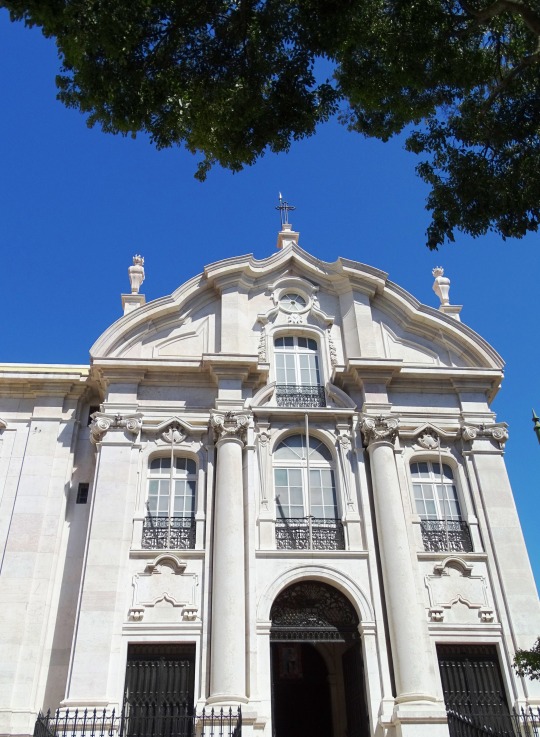
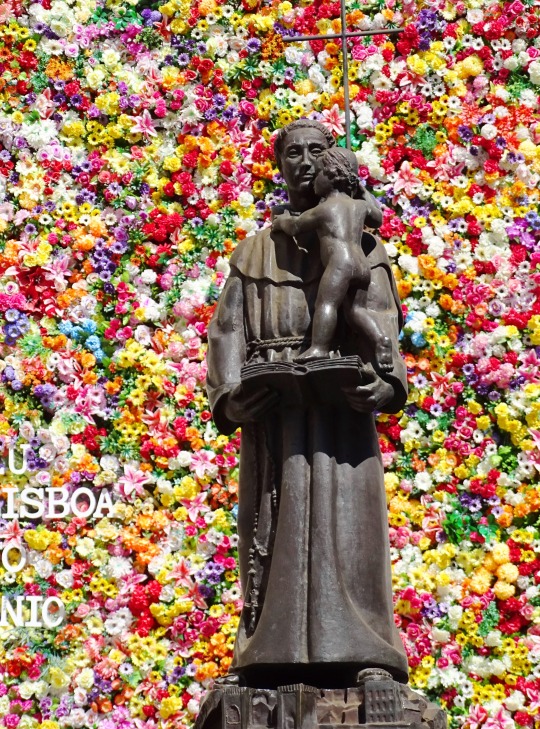
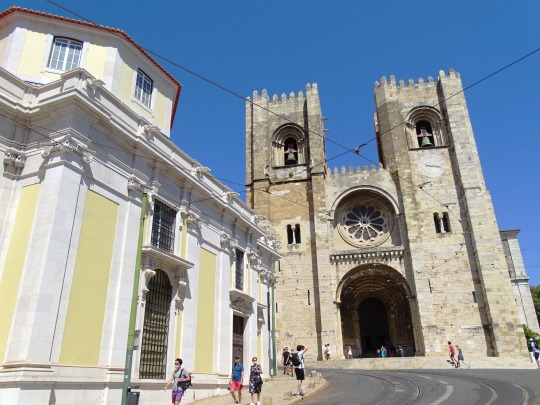
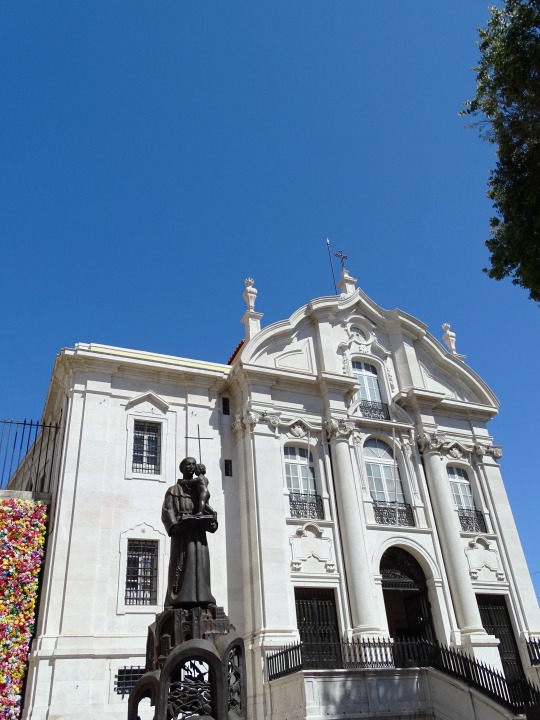
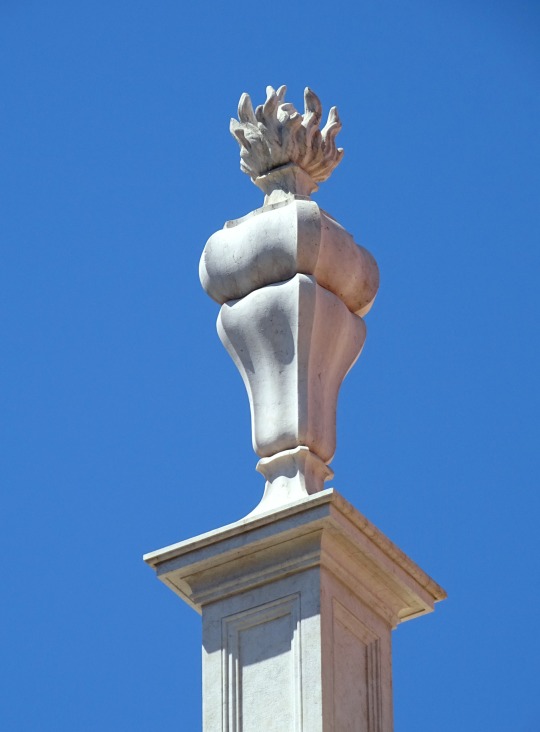

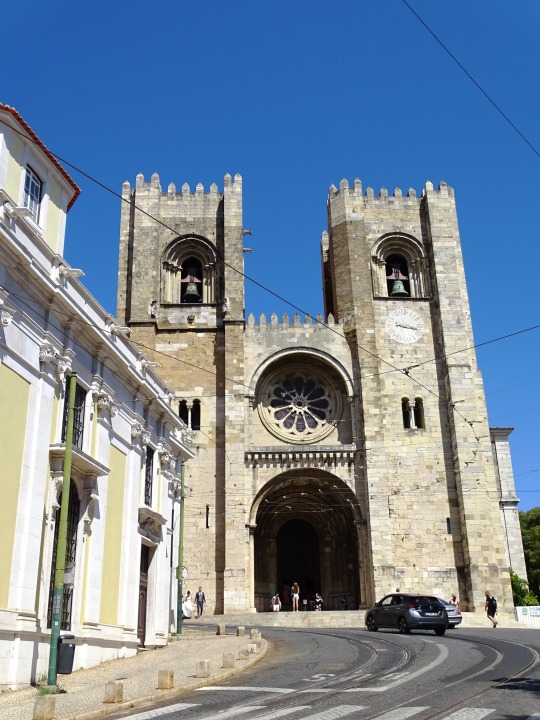
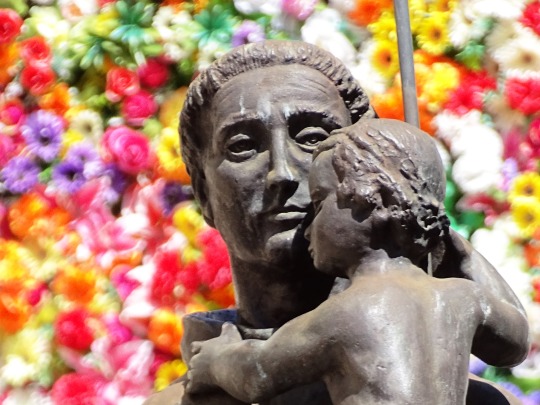
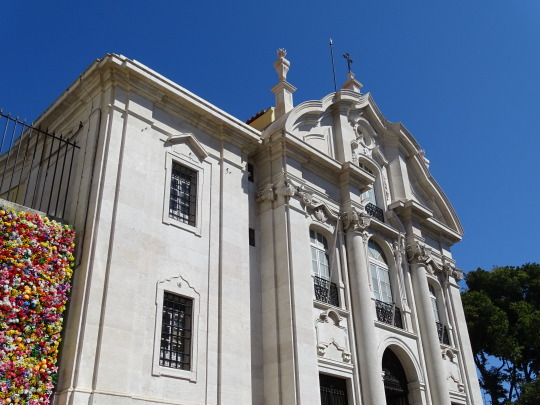
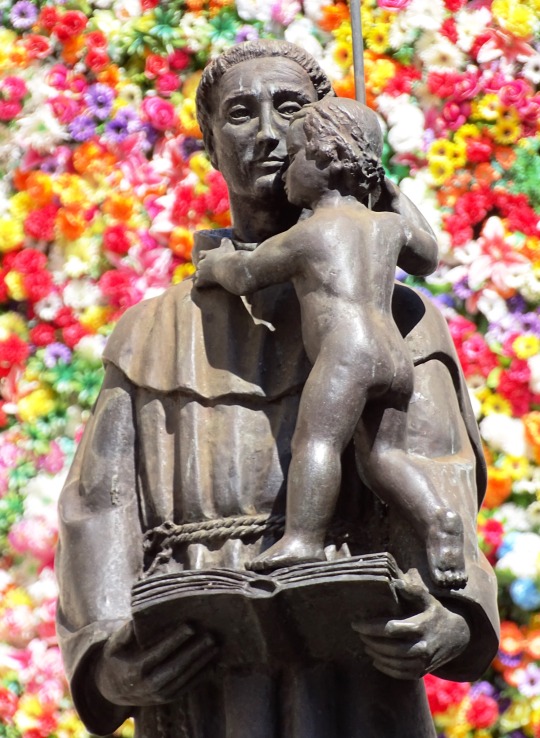
St Anthony's Church, Lisbon
The Church of Saint Anthony of Lisbon (Portuguese: Igreja de Santo António de Lisboa) is a Roman Catholic church located in Lisbon, Portugal. It is dedicated to Saint Anthony of Lisbon (also known in the Christian world as Saint Anthony of Padua). According to tradition, the church was built on the site where the saint was born, in 1195. The church is classified as a National Monument.
Fernando de Bulhões (known as Saint Anthony) was born in Lisbon, Portugal, in 1195, the son of a wealthy family. In 1220, while studying in Coimbra, he entered the Franciscan Order, adopting the name António. His missionary travels would lead him to Italy, where he settled in Padua. Due to his immense popularity, he was canonised less than a year after his death, in 1232.
The site of the family house where Fernando was born, located very close to Lisbon Cathedral, was turned into a small chapel in the 15th century. This early building, from which nothing remains, was rebuilt in the early 16th century, during the reign of King Manuel I. The Lisbon Senate was located on a house just beside the chapel. A religious brotherhood (Irmandade de Santo António) dedicated to the saint was founded in the 16th century.
In 1730, under King John V, the church was rebuilt and redecorated. In the 1755 Lisbon earthquake the Santo António Church was destroyed, with only the main chapel left standing. It was fully rebuilt after 1767 to a Baroque-Rococo design by architect Mateus Vicente de Oliveira. This is the church that can be visited today.
Since 1755, a procession leaves the church every June 13, passes by Lisbon Cathedral, and goes through the slopes of Alfama neighbourhood, located nearby. The 13th of June is Saint Anthony's day and is one of the "Popular Saint Festivities" celebrated by Lisbon. During the morning, special bread is given to the oldest women of each family.
On May 12, 1982, Pope John Paul II visited the church. He inaugurated a statue of Saint Anthony (by sculptor Soares Branco) in the square in front of the church and prayed in the crypt, which marks the spot where the saint was born.
Source: Wikipedia
#St Anthony's Church#Igreja de Santo António de Lisboa#Church of Saint Anthony of Lisbon#architecture#exterior#Lisbon Cathedral#cityscape#tourist attraction#landmark#original photography#summer 2021#Lisboa#Lisbon#Portugal#Southern Europe#vacatioh#travel#public art#sculpture#Statue of Santo António de Lisboa#Flowerwall by Susana Barros#Parede de flores
1 note
·
View note
Text
Today the church remembers St. Anthony of Padua, Priest, Friar, an Doctor of the Church.
Ora pro nobis.
He born Fernando Martins de Bulhões (15 August 1195 – 13 June 1231 AD) and was a Portuguese Catholic priest and friar of the Franciscan Order. He was born and raised by a wealthy family in Lisbon, Portugal, and died in Padua, Italy. Noted by his contemporaries for his powerful preaching, expert knowledge of scripture, and undying love and devotion to the poor and the sick, he was one of the most quickly canonized saints in church history. He was proclaimed a Doctor of the Church by Pope Pius XII on 16 January 1946. .
15th-century writers state that his parents were Vicente Martins and Teresa Pais Taveira, and that his father was the brother of Pedro Martins de Bulhões, the ancestor of the Bulhão or Bulhões family. His wealthy and noble family arranged for him to be instructed at the local cathedral school. At the age of 15, he entered the Augustinian community of Canons Regular of the Order of the Holy Cross at the Abbey of Saint Vincent on the outskirts of Lisbon.
In 1212, distracted by frequent visits from family and friends, he asked to be transferred to the motherhouse of the congregation, the Monastery of the Holy Cross in Coimbra, then the capital of Portugal. There, the young Fernando studied theology and Latin.
After his ordination to the priesthood, Fernando was named guestmaster at the age of 19, and placed in charge of hospitality for the abbey. While he was in Coimbra, some Franciscan friars arrived and settled at a small hermitage outside Coimbra dedicated to Anthony the Great. Fernando was strongly attracted to the simple, evangelical lifestyle of the friars, whose order had been founded only 11 years prior. News arrived that five Franciscans had been beheaded in Morocco, the first of their order to be killed. King Afonso II ransomed their bodies to be returned and buried as martyrs in the Monastery of Santa Cruz. Inspired by their example, Fernando obtained permission from church authorities to leave the Canons Regular to join the new Franciscan order. Upon his admission to the life of the friars, he joined the small hermitage in Olivais, adopting the name Anthony (from the name of the chapel located there, dedicated to Anthony the Great), by which he was to be known.
Anthony then set out for Morocco, in fulfilment of his new vocation. However, he fell seriously ill in Morocco and set sail back for Portugal in hope of regaining his health. On the return voyage, the ship was pushed off course and landed in Sicily. From Sicily, he made his way to Tuscany, where he was assigned to a convent of the order, but he was met with difficulty on account of his sickly appearance. He was finally assigned to the rural hermitage of San Paolo near Forlì, Romagna, a choice made after considering his poor health. There, he had recourse to a cell one of the friars had made in a nearby cave, spending time in private prayer and study.
In 1222, in the town of Forlì, a number of visiting Dominican friars were present for the occasion of an ordination, and a misunderstanding arose over who should preach. The Franciscans had expected that one of the Dominicans would occupy the pulpit, being renowned for their preaching. However, the Dominicans had come unprepared, thinking a Franciscan would be the homilist. In this quandary, the head of the hermitage, who did not think any of his own humble friars could give a homily for the occasion, called upon Anthony, whom he suspected was most qualified, and entreated him to speak whatever the Holy Spirit might inspire. Anthony objected, but was overruled, and his impromptu sermon created a deep impression on his audience. His audience was moved not only by his rich voice and arresting manner, but also by the theme and substance of his discourse, his deep knowledge of scripture, and the eloquence with which he delivered his message.
Anthony was then sent by Brother Gratian, the local minister provincial, to the Franciscan province of Romagna, based in Bologna. He soon came to the attention of the founder of the order, Francis of Assisi. Francis had held a strong distrust of the place of theological studies in the life of his brotherhood, fearing it might lead to an abandonment of their commitment to a life of real poverty and service. In Anthony, however, he found a kindred spirit who shared his vision and could also provide the teaching any young members of the order seeking ordination might need. In 1224, he entrusted the pursuit of studies for any of his friars to the care of Anthony.
The traditional practice of praying for St. Anthony's help in finding lost or stolen things is traced to an incident during his lifetime that occurred in Bologna. According to the story, Anthony had a book of psalms that was important to him, as it contained his notes and comments for use in teaching his students. A novice who had chosen to leave had taken the psalter with him. Prior to the invention of the printing press, any book was hand-copied, and thus, an item of high value; a Franciscan friar in particular, given his vow of poverty, would have found such an item difficult to replace. When Anthony realized his psalter was missing, he prayed it would be found or returned, after which the thief was moved to not only return the book to Anthony, but also return to the order. The stolen book is said to be preserved in the Franciscan friary in Bologna.
Occasionally, Anthony took another post as a teacher at universities such as University of Montpellier and University of Toulouse in southern France, but his preaching was considered to be his supreme gift. According to historian Sophronius Clasen, Anthony preached "the grandeur of Christianity". His method included allegory and symbolical explanation of scripture. In 1226, after attending the general chapter of his order held at Arles, France, and preaching in the region of Provence, Anthony returned to Italy and was appointed Provincial superior of northern Italy. He chose the city of Padua as his location.
In 1228, he served as envoy from the general chapter to Pope Gregory IX. At the papal court, his preaching was hailed as a "jewel case of the Bible" and he was commissioned to produce his collection of sermons, Sermons for Feast Days (Sermones in Festivitates). Gregory IX described Anthony as the "Ark of the Testament" (Doctor Arca testamenti).
Anthony became sick with ergotism in 1231, and went to the woodland retreat at Camposampiero with two other friars for a respite. There, he lived in a room built for him under the branches of a walnut tree. Anthony died on the way back to Padua on 13 June 1231 at the Poor Clare monastery at Arcella (now part of Padua), at the age of 35.
According to his request, Anthony was buried in the small church of Santa Maria Mater Domini (probably dating from the late 12th century) and near a convent which had been founded by him in 1229. Nevertheless, due to his increased notability, construction of a large basilica began around 1232, although it was not completed until 1301. The smaller church was incorporated into the structure as the Cappella della Madonna Mora (Chapel of the Dark Madonna). The basilica is commonly known today as "Il Santo" (The Saint).
Anthony was canonized by Pope Gregory IX on 30 May 1232, at Spoleto, Italy, less than one year after his death. In the words of Pope Benedict XVI:
The richness of spiritual teaching contained in the Sermons was so great that in [16 January] 1946 Venerable Pope Pius XII proclaimed Anthony a Doctor of the Church, attributing to him the title Doctor evangelicus, for his devoted study of the Gospels in particular.
Almighty God, you gave to your servant Anthony special gifts of grace to understand and teach the truth as it is in Christ Jesus:
Grant that by this teaching we may know you, the one true God, and Jesus Christ whom you have sent; who lives and reigns with you and the Holy Spirit, one God, forever and ever. Amen.

#father troy beecham#christianity#troy beecham episcopal#jesus#father troy beecham episcopal#saints#god#salvation#peace#faith#theology#new testament#monasticism
4 notes
·
View notes
Text
SAINT OF THE DAY (June 13)

On June 13, Catholics honor the memory of the Franciscan priest St. Anthony of Padua.
Although he is popularly invoked today by those who have trouble finding lost objects, he was known in his own day as the “Hammer of Heretics” due to the powerful witness of his life and preaching.
The saint known to the Church as Anthony of Padua was not born in the Italian city of Padua, nor was he originally named Anthony.
He was born as Ferdinand on 15 August 1195 in Lisbon, Portugal, the son of an army officer named Martin and a virtuous woman named Mary.
They had Ferdinand educated by a group of priests, and the young man made his own decision to enter religious life at age 15.
Ferdinand initially lived in a monastery of the Augustinian order outside of Lisbon. But he disliked the distraction of constant visits from his friends and moved to a more remote house of the same order.
There, he concentrated on reading the Bible and the Church Fathers, while living a life of asceticism and heartfelt devotion to God.
Eight years later, in 1220, Ferdinand learned the news about five Franciscan friars who had recently died for their faith in Morocco.
When their bodies were brought to Portugal for veneration, Ferdinand developed a passionate desire to imitate their commitment to the Gospel.
When a group of Franciscans visited his monastery, Ferdinand told them he wanted to adopt their poor and humble way of life.
Some of the Augustinian monks criticized and mocked Ferdinand's interest in the Franciscans, which had been established only recently, in 1209.
However, prayer confirmed his desire to follow the example of St. Francis, who was still living at the time.
He eventually obtained permission to leave the Augustinians and join a small Franciscan monastery in 1221.
At that time, he took the name Anthony, after the fourth-century desert monk, St. Anthony of Egypt.
Anthony wanted to imitate the Franciscan martyrs who had died trying to convert the Muslims of Morocco.
He traveled on a ship to Africa for this purpose, but became seriously ill and could not carry out his intention.
The ship that was supposed to take him to Spain for treatment was blown off course and ended up in Italy.
Through this series of mishaps, Anthony ended up near Assisi, where St. Francis was holding a major meeting for the members of his order.
Despite his poor health, Anthony resolved to stay in Italy in order to be closer to St. Francis himself.
He deliberately concealed his deep knowledge of theology and Scripture. He offered to serve in the kitchen among the brothers.
At the time, no one realized that the future “Hammer of Heretics” was anything other than a kitchen assistant and obedient Franciscan priest.
Around 1224, however, Anthony was forced to deliver an improvised speech before an assembly of Dominicans and Franciscans, none of whom had prepared any remarks.
His eloquence stunned the crowd, and St. Francis himself soon learned what kind of man the dishwashing priest really was.
In 1224, he gave Anthony permission to teach theology in the Franciscan order – “provided, however, that as the Rule prescribes, the spirit of prayer and devotion may not be extinguished.”
Anthony taught theology in several French and Italian cities, while strictly following his Franciscan vows and preaching regularly to the people.
Later, he dedicated himself entirely to the work of preaching as a missionary in France, Italy and Spain, teaching an authentic love for God to many people – whether peasants or princes – who had fallen away from Catholic faith and morality.
Known for his bold preaching and austere lifestyle, Anthony also had a reputation as a worker of miracles, which often came about in the course of his disputes with heretics.
His biographers mention a horse, which refused to eat for three days, and accepted food only after it had placed itself in adoration before the Eucharist that Anthony brought in his hands.
Another miracle involved a poisoned meal, which Anthony ate without any harm after making the sign of the Cross over it.
And a final often recounted miracle of St. Anthony’s involved a group of fish, who rose out of the sea to hear his preaching when heretical residents of a city refused to listen.
After Lent in 1231, Anthony's health was in decline.
Following the example of his patron – the earlier St. Anthony, who had lived as a hermit – he retreated to a remote location, taking two companions to help him.
When his worsening health forced him to be carried back to the Franciscan monastery in Padua, crowds of people converged on the group in hopes of paying their homage to the holy priest.
The commotion surrounding his transport forced his attendants to stop short of their destination.
After receiving the last rites, Anthony prayed the Church's seven traditional penitential psalms, sung a hymn to the Virgin Mary, and died on 13 June 1231 at the age of 36.
St. Anthony's well-established holiness, combined with the many miracles he had worked during his lifetime, moved Pope Gregory IX – who knew the saint personally – to canonize him one year after his death, on 30 May 1232.
“St. Anthony, residing now in heaven, is honored on earth by many miracles daily seen at his tomb, of which we are certified by authentic writings,” proclaimed the 13th-century Pope.
5 notes
·
View notes
Text
How To Actually Find Items -- Properly

I saw a video a while back on Facebook about this guy who was telling a story about his mother and how she misplaces his father’s check. He said that she was saying something in Spanish and next thing he knew, she found the check.
Meet Saint Anthony. I personally don’t work with deities because the pressure of making sure you give them offerings, and keeping up with those offerings seem like a lot work to me, especially when an offering isn’t made the experience of working with them can go very south gives me anxiety. Plus, I’m truly forgetful so I’d be setting myself up for disaster, anyways, since I’ve been on my journey I found that you can work with the energy of a deity instead of actually working with one. By that I mean, instead of having them do things for you such as, helping with manifestations, possibly hexing someone, or working with a deity to help other people, which would then cause you to have to make an offering to them, you can somewhat work with their energy.
Not every deity will allow this and they will let you know but Saint Anthony, who worked and helped this sick and poor, his been really helpful in my journey especially when it comes to finding things.
A little back story on Saint Anthony is he was a Portuguese Catholic Priest who was raised by a wealthy family in Lisbon, Portugal and died in Padua, Italy. He was known for his expert knowledge in scripture, undying devotion to the poor and sick, and quickly became canonized saint in church history. His birthday is August 15, 1195 and past away June 13, 1231 which is also his feast day.
Saint Anthony is the Saint of lost or stolen items as well as other things because their was an incident that happened while he was in Bologna. He had a book of psalms where he had wrote his notes and comments he used to teach to his students. During this time books were hand-copied so this was a very valuable item at the time. When Anthony realized the book was gone he prayed to God that the book would be returned or found; the novice returned the book right to him.
Like I mentioned before I don’t work with deities, but the times I’ve asked Saint Anthony to help me find things I’d always make sure to thank him and to also not use him ALL the time too.
This is the prayer:
Dear St. Anthony, please come around: something is lost, and it cannot be found
Or
Tony, Tony, look around. Something’s lost and must be found!
Since Saint Anthony is helping us to find items, I think it’s only appropriate to honor him on his feast day which is June 13. The foods that are usually present on his feast day is pizza (like oven brick), peppers and onions, clams (but it’s like hard and round clams), arancini (which is an Italian snack consisting of a ball of rice coated with bread crumbs and then deep fried), zeppole (an Italian pastry that’s deep fried dough with powder sugar on top and filled with custard, jelly, cannoli style cream or butter and honey mixture), and my favorite gelato.
With everything else in life, make sure to do your own research on Saint Anthony because he is also the Saint of finding love, miracles, to make requests, and for healing.
34 notes
·
View notes
Text
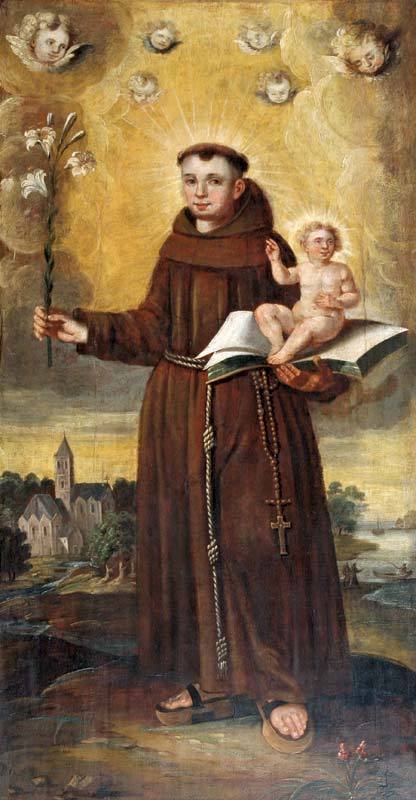
Saint Anthony, The Miracle Worker
June 13th - Today is the Feast Day of Saint Anthony of Padua. Ora pro nobis. (Pray for us)
He is one of the most famous saints of the Church, known universally as the super-competent manager of the celestial “Lost and Found” department. (“Tony, Tony, come around; something’s lost and can’t be found” is a prayer whispered by millions.)
For those of us accustomed to this familiar relationship, however, it may come as a shock to learn who Saint Anthony of Padua, O.F.M. actually was. For though he only lived 35 years, Anthony was renowned during his lifetime for his forceful preaching and expert knowledge of scripture – and for his miracles.
So well regarded was he, in fact, that in all of the 2000-year history of the Church, Anthony was to become the second-most-quickly canonized saint, after Peter of Verona. Anthony was canonized by Pope Gregory IX on 30 May 1232, at Spoleto, Italy, less than one year after his death.

Fernando’s Life Plans, Changed
Fernando Martins de Bulhões was born in 1195 to an aristocratic Lisbon family and initially joined the Augustinians at the age of fifteen. He was the guest master for their abbey containing the famous library at Coimbra, when his whole world suddenly changed.
Franciscan friars had settled at a small hermitage nearby; their Order had been founded only eleven years before. News soon arrived that five Franciscans had been beheaded in Morocco; the King ransomed their bodies to be returned and buried as martyrs in the Abbey.
Inspired by their example and strongly attracted to their simple, evangelical lifestyle, Fernando obtained permission to join the new Order, upon his admission adopting the name ‘Anthony.’ He then set out for Morocco; however, he fell seriously ill and on the return voyage his ship was blown off course and landed in Sicily. When he found his way to northern Italy, Anthony was finally assigned to a rural Franciscan hermitage, due to his poor health. There he lived in a cell in a nearby cave, where he spent much time in private prayer and study.
ANTHONY THE HOMILIST: One Sunday in 1222 a number of Dominican friars visited for an ordination and a misunderstanding arose as to who should preach. The Dominicans were renowned for their preaching, but had come unprepared, thinking that a Franciscan would be the homilist. Anthony was entreated him to speak whatever the Holy Spirit should inspire him with; his homily that day created a deep impression and began his career as a speaker. By 1224, St Francis of Assisi, founder of the Order, entrusted Anthony with the theological preparation for his priests.
Anthony focused on the grandeur of Christianity in his homilies and when a few years later he was sent as the envoy from the Franciscans to Pope Gregory IX, the Pope commissioned his collection, Sermons for Feast Days (Sermones in Festivitates). Gregory IX himself described him as the “Ark of the Testament.”
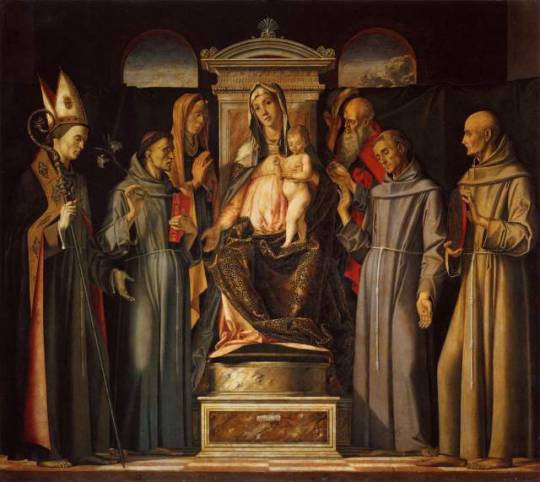
ANTHONY THE MIRACLE WORKER: The stories of Anthony’s 13th century miracles make fascinating reading for today’s Catholic. Despite their obvious folkloric tone, it is the miracles’ utter originality that impresses most. One comes away thinking that such astonishing occurrences can only be fairy tales — or the special kind of reality that seems to envelope the saints. As there are far too many miracles to recount here, we’ll focus on three of the most famous:
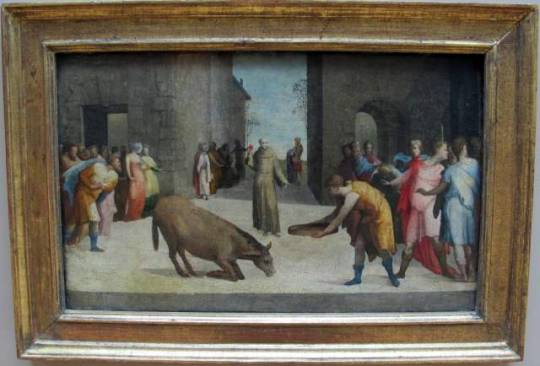
THE KNEELING MULE: The teaching of the Real Presence was disparaged in northern Italy during the 1200s, as the gnostic heresy of the Albigensians had spread from France. One day, Anthony was publically challenged. “The heretic stood up and said: ‘I’ll keep my beast of burden locked up for three days and I will starve him. After three days, in the presence of other people, I’ll let him out and I’ll show him some prepared fodder. You, on the other hand will show him what you believe to be the body of Christ. If the starving animal, ignoring the fodder, rushes to adore his God, I will sincerely believe in the faith of the Church.’
“The saint agreed straight away. God’s servant entered a nearby chapel, to perform the rites of the Mass with great devotion. Once finished, he exited where the people were waiting, carrying reverently the body of the Lord. The hungry mule was led out of the stall, and shown appetizing food. The man of God said to the animal with great faith: “In the name of virtue and the Creator, who I, although unworthy, am carrying in my hands, I ask you, o beast, and I order to come closer quickly and with humility and to show just veneration, so that the malevolent heretics will learn from this gesture that every creature is subject to the Lord, as held in the hands with priestly dignity on the altar”.
God’s servant had hardly finished speaking, when the animal, ignoring the fodder, knelt down and lowered his head to the floor, thus genuflecting before the living sacrament of the body of Christ.”
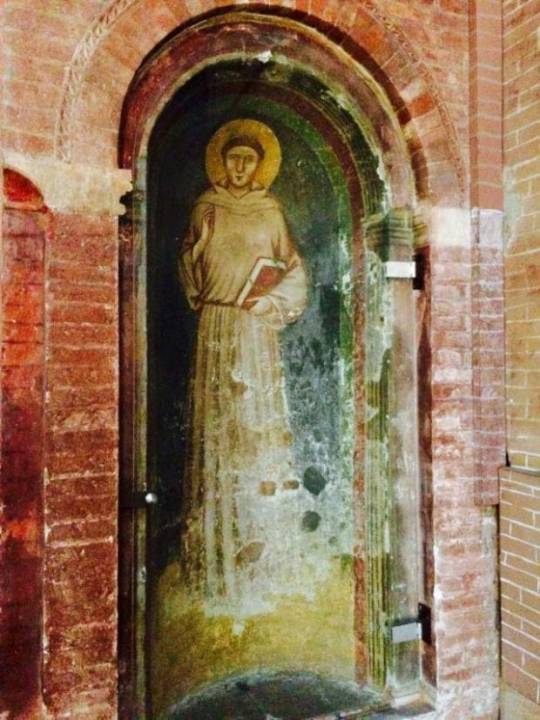
THE LISTENING FISH: The story takes place in Rimini, a port on the Adriatic near Padua. On a Sunday morning, the Saint found the fishermen there not at Mass. He began to preach to them and met only with ridicule. Anthony then stood at the edge of the water, looked in the distance, and proclaimed so that everyone would hear:
“’From the moment in which you proved yourselves to be unworthy of the Word of the Lord, look, I turn to the fish, to further confound your disbelief.’
“And filled with the Lord’s spirit, he began to preach to the fish, elaborating on their gifts given by God: how God had created them, how He was responsible for the purity of the water and how much freedom He had given them, and how they were able to eat without working.
“The fish began to gather together to listen to this speech, lifting their heads above the water and looking at him attentively, with their mouths open. As long as it pleased the Saint to talk to them, they stayed there listening attentively, as if they could reason. Nor did they leave their place, until they had received his blessing.
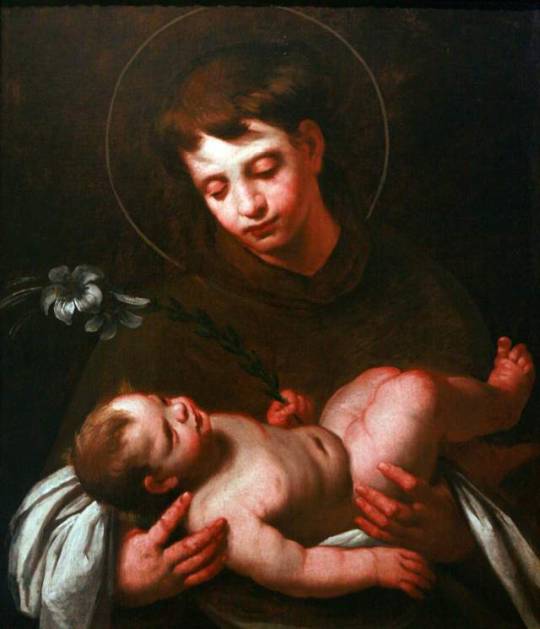
ANTHONY & THE BABY JESUS: Anthony was welcomed by a local resident in an Italian town where he was to preach. His host gave him a room set apart, so that he could study and contemplate undisturbed. Soon, however, his curiosity about his famous guest overcame him and his host peeped through Anthony’s window. What he saw there has been immortalized in almost every Catholic Church in the world. “A beautiful joyful baby appear in blessed Anthony’s arms. The Saint hugged and kissed him, contemplating the face with unceasing attention. The landlord was awed and enraptured by the child’s beauty, and shocked when, after a long time spent in prayer, the vision disappeared; the Saint called the landlord, and he forbade him from telling anyone what he had seen. After the Saint passed away, the man told the tale crying, swearing on the Bible that he was telling the truth.”
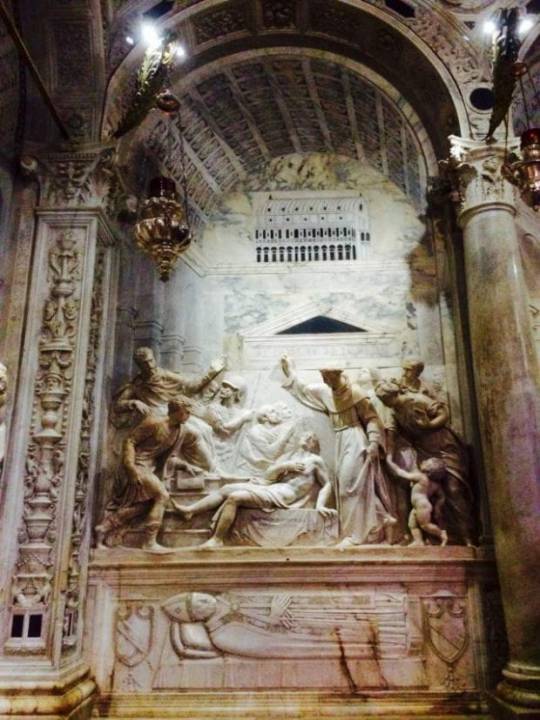
SOMETHING’S LOST AND CAN’T BE FOUND: An incident in the university city of Bologna is the origin of the Saint’s fame as a finder of lost items, people and spiritual goods. Anthony possessed a book of psalms with valuable notes and comments for use in teaching his students. A novice who had decided to leave the Order stole the prized psalter. Anthony prayed his psalter would be found or returned. The thief was moved to restore the book to Anthony and return to the Order. The stolen book is said to be preserved in the Franciscan friary in Bologna.
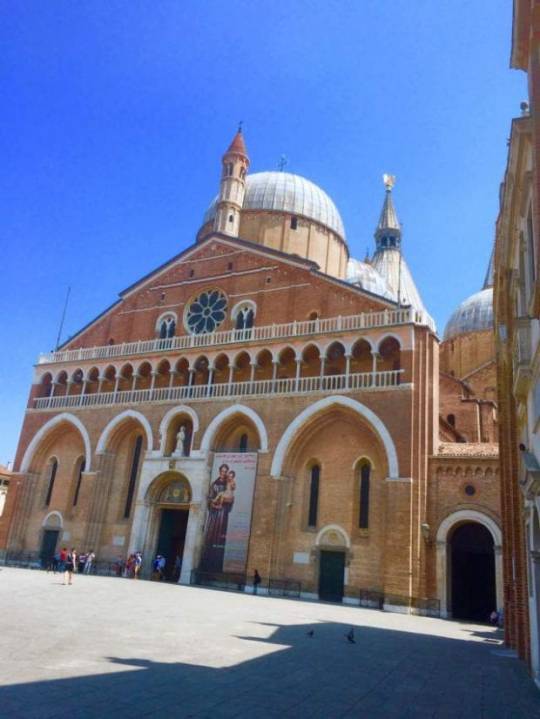
THE FAME OF ST. ANTHONY SPREAD GLOBALLY with the former Portuguese Empire and with the diaspora of 19th and 20th century Italian emigrants. Stories of the Saint’s interventions are reported, therefore, from the four corners of the earth:
In Siolim, a village in the Indian state of Goa, St. Anthony is always shown holding a serpent on a stick . This is a depiction of the incident which occurred during the construction of the church wherein a snake was disrupting construction work. The people turned to St. Anthony for help, and placed his statue at the construction site. The next morning, the snake was found caught in the cord placed in the statue’s hand.
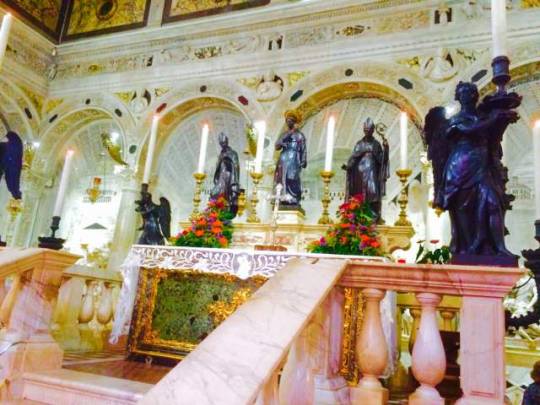
THE GRAVE OF SAINT ANTHONY OF PADUA: Anthony was proclaimed a Doctor of the Church on 16 January 1946, and his Basilica in Padua contains his mortal remains.
By Fr. Francis Xavier Weninger, 1877
St. Anthony, who derived his surname from the city of Padua, in Italy, because he spent many years there in preaching the Gospel, was a native of Lisbon, in Portugal. He received, in holy baptism, the name of Ferdinand, and was very piously educated by his parents. No sooner had he become acquainted with the dangers of the world, than he, in the fifteenth year of his age, to be safe from temptation, went into the cloister of the regular Canons, which is not far from Lisbon, where he also made his religious vows. As, however, he was disturbed too much there by the visits of his friends, he went, with the permission of his superiors, to Coimbra, into the monastery of the Holy Cross. To this house came, one day, five friars of the Order of St. Francis, who were travelling to Africa to preach the Gospel to the Moors. They suffered martyrdom, however, soon after their arrival there, and their holy bodies were brought back to the monastery of the Holy Cross, at Coimbra, and solemnly interred in the church attached to it. Antony, hearing how fearlessly these martyrs had preached the true faith and had suffered for Christ’s sake, conceived an intense desire to preach the Gospel to the heathen and to give his life for the word of God. Hence, he determined to enter the Order of St. Francis, that he might have an opportunity to gratify the wishes of his heart.
After much hardship, he was at length, when 20 years of age, received into the Order, and after his novitiate, he obtained permission to sail for Africa and preach the Gospel to the Saracens. Scarcely had he arrived there, when God proved him by a severe sickness, which exhausted all his strength, and forced him to return to Spain. The ship, however, in which he embarked for home, encountered contrary winds, and instead of going to Spain, was driven to Sicily. No sooner had he set foot on land, than he heard that St. Francis, the holy founder of his order, had called a general chapter at Assisium. He immediately went thither, in order to receive the blessing of the Saint, which was cheerfully given. When the assemblage dispersed, not one among the superiors was found willing to be burdened with Antony, who was greatly enfeebled by his long illness, and moreover, was thought to be not quite sane. The Father Provincial of the Roman province was at last moved with compassion, and sent him to a house called Mount St. Paul, which was situated in a wilderness. There St. Antony lived a most austere life, performing the most humble labor, and occupying all his other time with prayers and holy meditations.
After passing several years in this manner, he was sent with a few other religious to Forli to be ordained priest. The guardian of the monastery requested the Dominican priests, who had also assembled there, that one of them should make an exhortation or deliver a short sermon. As they all excused themselves from so doing, he said, more in jest than in earnest, that brother Antony should speak to those assembled. Antony obeyed, and delivered so eloquent a sermon that all were astonished at his knowledge and ability, as, until now, they had deemed him one of the least gifted. Not willing that his extraordinary talent should any longer be hidden, St. Francis himself had him ordained priest, and gave him a double employment, namely, to instruct his brethren in theology and also to preach. The duties of both functions were discharged by him, with great credit to himself and an indescribable benefit to others. He converted the most hardened sinners by his sermons, and among others induced twenty-two murderers to do penance and change their wicked course of life. The heretics he convinced so thoroughly of their errors, that they could not withstand him, on account of which he was called the “Hammer of the heretics.”
Many of them he converted to the true faith, among whom was Bonovillus, who had denied the substantial presence of Christ in the Blessed Sacrament. Not able to reply to Antony’s arguments he requested the following miracles. Having starved his ass for three days, he was to bring him food at the same time that Saint Antony should come with the holy Eucharist; and if the beast, before touching his food, should fall down before the Blessed Sacrament, he would believe the Saint’s words. At the appointed time, the Saint arrived with the Blessed Sacrament, accompanied by many Catholics, and addressing the ass, which was held by Bonovillus, he said: “I command thee, in the name of thy Creator and my Saviour, whom I, although an unworthy priest, carry at this moment in my hands, that you come, in all humility, and pay Him due honors.” Bonovillus, at the same time, threw down the animal’s food and called him to come and eat. But without touching the food, the ass fell down on his fore knees, and bent his head. The Catholics rejoiced at this incontestable miracle, but the heretics hid their heads and Bonovillus was converted. At Rimini, the chief seat of the heretics, he ascended the pulpit; but as no heretic would come and listen to him, the Saint went to the sea-shore, where just at that time many of them were standing, and called to the fishes to hear his words, as men would not be instructed. And behold! suddenly a great number of fishes raised their heads out of the water, as if to listen. Speaking for a short time of their Creator, he blessed and dismissed them. This miracle caused the heretics to listen more attentively to St. Antony and to follow his admonitions.
At another time, he made the sign of the cross over a goblet filled with poison, and drank it without being harmed. The cause of his doing this was that some heretics promised to return to the true Church, if he would drink the poison and not die. A perpetual miracle was the fact that, although he preached only in one language, yet all his hearers understood him, no matter what might be their nationality.
Who can count all the miracles God wrought through this Saint, or who can sufficiently praise the wonderful gifts with which he was graced? More than once it happened that at the same time when he was standing in the pulpit to preach, he appeared also in the choir and sang the lesson of the daily office of the Church, which was pointed out to him. He prophesied many future events and knew by divine revelation many secrets of the heart. There lived, in a French city, a writer, who publicly led a most immoral life. St. Antony resided for some time in this city, and as often as he met this man, he bowed very low to him. The writer, on perceiving it, was greatly incensed, as he believed it was done by the holy man only to deride him: hence he reproached him with menacing words. The Saint, however, replied: “Be not surprised that I show such respect to you before others. I have long prayed God for the grace to die a martyr, but it has not been granted me. You, however, will receive this honor, and therefore I evince such particular respect for you.” Although the writer laughed and made a mockery of this prophecy, yet the future showed that the Saint had spoken the truth. After the expiration of some time, this immoral man made a voyage to the Holy Land, in company with the Bishop of the city. On arriving there, he was seized by the Saracens, who demanded of him that he should deny his faith. He, however, remained firm in confessing it, and after having been greatly tormented, he suffered the death of a martyr.
St. Antony was as undaunted and fearless in punishing the wicked, when circumstances required it, as he was famous by the gift of prophecy. At that period Florence was governed by Ezelinus, who, among other cruel deeds, had executed 11,000 men of Padua, part of whom were in his service and part in garrison at Verona, because the inhabitants of Padua had rebelled. Nobody dared to oppose this tyrant in the execution of further barbarities but St. Antony, who had sufficient courage to go to him, and representing most powerfully his inhuman conduct, threatened him with the just wrath of the Almighty and the torments of hell, in case he repented not and abstained from, his tyranny.
During this menace flames of fire darted from the countenance of St. Antony, as Ezelinus afterwards related, which so thoroughly frightened the tyrant, that he fell trembling at the feet of the Saint, and most earnestly promised repentance. As he converted this and many other sinners by admonition, he moved others , in a different way to do penance. Many said that he had suddenly appeared before them at night and exhorted them to repent. “Rise quickly, said he at such times, and confess the sin by which you have offended the majesty of God.”
I should hardly know where to end, were I to relate all that St. Antony did to convert sinners, or how many future events he foretold. I will mention only a few more facts, from which the conclusion may be drawn that, as the holy man appeared in different places at the same time, so also, by the power of God, he was miraculously transported, in one moment, from one place to another. The father of St. Antony resided at Lisbon in Portugal, as treasurer of the royal revenues, the duties of which office he discharged with fidelity and integrity. One day, he was requested by some gentlemen in the king’s service to advance them some money out of the king’s treasury, making a verbal promise to return the same in a short time. The pious treasurer, who neither feared deception nor danger, gave them what they asked, without taking a written receipt. When the time arrived at which he had to deliver his account, he asked the officers for the borrowed money, but they denied having received any. This perfidy grieved the kind man deeply, and he knew not what to do. Seeking refuge in fervent prayers to God, he received help in a miraculous way through his son, who resided at that time in Italy. At the time he was to appear before the royal judge to be sentenced to return the missing money, his holy son suddenly appeared in the room, and addressed the officers in the following manner: “This kind man, my father, has advanced you, upon your request, a sum of money out of the royal treasury, on such a day, at such an hour, in such a place, as is well known to you. I warn you to return it to him and to indemnify him; otherwise, divine vengeance will strike you, and you will be heavily punished.” The guilty men were not less astonished at the presence of the holy man, than at his menaces and the revelation of their wickedness. They immediately testified in writing how much each of them had received, promising at the same time to repay it in a short time. No sooner was this done, than the Saint disappeared from their view.
This pious treasurer was in still greater danger at another time. He was accused of having committed murder, and sentence was to be executed on him and his servant on the following day. Antony was at Padua; but God revealed to him what had taken place at Lisbon. The Saint asked permission of his superior to seek some recreation out of the city. Hardly was he out of the place, when, like Habakuk, he was carried by an angel through the air to Lisbon. He went to the judge and represented his father’s innocence. Finding, however, no willing ear in the judge, he repaired to the grave of the murdered man, commanded him to rise, and leading him to the judge, he requested of him to say if his father was the man, who, with the aid of his servant had assassinated him. The risen man replied distinctly: “No: it was not he.” The Judge requested that St. Antony should demand of him the name of the real murderer: the Saint, however, replied: ” I have not come to bring death to a guilty man, but to rescue the innocent.” Upon this, his father and his servant were released, and Antony was carried back to Padua by the angel.
After this wonder-working servant of God had filled all Italy and France with the fame of his miracles and conversions, God revealed to him his approaching last hour. He repaired to an isolated spot, and having prepared himself for his end, he returned very sick to Padua, received extreme unction, recited the seven Penitential Psalms, and his usual prayer: “O Glorious Lady, &c.” The divine mother appeared to him with the child Jesus, and the Saint conversed with them most lovingly until his pure soul went to the abode of the blessed. This took place in 1231, when he was hardly 36 years of age. They desired to keep his death concealed from the people for some time, but the little children proclaimed it by calling out in the streets: “The Saint is dead.” Thirty-two years later, when his holy remains were raised, his tongue was found entirely incorrupt. St. Bonaventure taking it in his-hand, said: “O blessed tongue, which always praised God and taught others how to praise Him! Now we have evidence how great thy merits were before God!”
The Saint is generally represented with the divine Child, as He appeared to him and embraced him. The lilies are also dedicated to him as an emblem of his unspotted innocence and purity. It is well known that this Saint is invoked when things are lost or have been purloined. Countless occurrences show at this day that the intercession of this Saint is powerful at the throne of the Almighty.
By: Beverly Stevens
6 notes
·
View notes
Text
Events 1.1
Pre-Julian Roman calendar
153 BC – For the first time, Roman consuls begin their year in office on January 1. Early Julian calendar (before Augustus' leap year correction) 45 BC – The Julian calendar takes effect as the civil calendar of the Roman Empire, establishing January 1 as the new date of the new year. 42 BC – The Roman Senate posthumously deifies Julius Caesar.
Julian calendar
193 – The Senate chooses Pertinax against his will to succeed Commodus as Roman emperor. 404 – Saint Telemachus tries to stop a gladiatorial fight in a Roman amphitheatre, and is stoned to death by the crowd. This act impresses the Christian Emperor Honorius, who issues a historic ban on gladiatorial fights. 417 – Emperor Honorius forces Galla Placidia into marriage to Constantius, his famous general (magister militum) (probable). 1001 – Grand Prince Stephen I of Hungary is named the first King of Hungary by Pope Sylvester II (probable). 1068 – Romanos IV Diogenes marries Eudokia Makrembolitissa and is crowned Byzantine Emperor. 1259 – Michael VIII Palaiologos is proclaimed co-emperor of the Empire of Nicaea with his ward John IV Laskaris. 1438 – Albert II of Habsburg is crowned King of Hungary. 1502 – The present-day location of Rio de Janeiro, Brazil, is first explored by the Portuguese. 1515 – Twenty-year-old Francis, Duke of Brittany, succeeds to the French throne following the death of his father-in-law, Louis XII. 1527 – Croatian nobles elect Ferdinand I of Austria as King of Croatia in the Parliament on Cetin. 1600 – Scotland recognises January 1 as the start of the year, instead of March 25. 1651 – Charles II is crowned King of Scotland. 1700 – Russia begins using the Anno Domini era instead of the Anno Mundi era of the Byzantine Empire.
Gregorian calendar
1707 – John V is proclaimed King of Portugal and the Algarves in Lisbon. 1739 – Bouvet Island, the world's remotest island, is discovered by French explorer Jean-Baptiste Charles Bouvet de Lozier. 1772 – The first traveler's cheques, which could be used in 90 European cities, are issued by the London Credit Exchange Company. 1773 – The hymn that became known as "Amazing Grace", then titled "1 Chronicles 17:16–17", is first used to accompany a sermon led by John Newton in the town of Olney, Buckinghamshire, England. 1776 – American Revolutionary War: Norfolk, Virginia is burned by combined Royal Navy and Continental Army action. 1776 – General George Washington hoists the first United States flag, the Grand Union Flag, at Prospect Hill. 1781 – American Revolutionary War: One thousand five hundred soldiers of the 6th Pennsylvania Regiment under General Anthony Wayne's command rebel against the Continental Army's winter camp in Morristown, New Jersey in the Pennsylvania Line Mutiny of 1781. 1788 – First edition of The Times of London, previously The Daily Universal Register, is published. 1801 – The legislative union of Kingdom of Great Britain and Kingdom of Ireland is completed, and the United Kingdom of Great Britain and Ireland is proclaimed. 1801 – Ceres, the largest and first known object in the Asteroid belt, is discovered by Giuseppe Piazzi. 1803 – Emperor Gia Long orders all bronze wares of the Tây Sơn dynasty to be collected and melted into nine cannons for the Royal Citadel in Huế, Vietnam. 1804 – French rule ends in Haiti. Haiti becomes the first black-majority republic and second independent country in North America after the United States. 1806 – The French Republican Calendar is abolished. 1808 – The United States bans the importation of slaves. 1810 – Major-General Lachlan Macquarie officially becomes Governor of New South Wales. 1822 – The Greek Constitution of 1822 is adopted by the First National Assembly at Epidaurus. 1834 – Most of Germany forms the Zollverein customs union, the first such union between sovereign states. 1847 – The world's first "Mercy" Hospital is founded in Pittsburgh, United States, by a group of Sisters of Mercy from Ireland; the name will go on to grace over 30 major hospitals throughout the world. 1860 – The first Polish stamp is issued, replacing the Russian stamps previously in use. 1861 – Liberal forces supporting Benito Juárez enter Mexico City. 1863 – American Civil War: The Emancipation Proclamation takes effect in Confederate territory. 1877 – Queen Victoria of the United Kingdom is proclaimed Empress of India. 1885 – Twenty-five nations adopt Sandford Fleming's proposal for standard time (and also, time zones). 1890 – Eritrea is consolidated into a colony by the Italian government. 1892 – Ellis Island begins processing immigrants into the United States. 1898 – New York, New York annexes land from surrounding counties, creating the City of Greater New York. The four initial boroughs, Manhattan, Brooklyn, Queens, and The Bronx, are joined on January 25 by Staten Island to create the modern city of five boroughs. 1899 – Spanish rule ends in Cuba. 1901 – The Southern Nigeria Protectorate is established within the British Empire. 1901 – The British colonies of New South Wales, Queensland, Victoria, South Australia, Tasmania, and Western Australia federate as the Commonwealth of Australia; Edmund Barton is appointed the first Prime Minister. 1902 – The first American college football bowl game, the Rose Bowl between Michigan and Stanford, is held in Pasadena, California. 1910 – Captain David Beatty is promoted to Rear admiral, and becomes the youngest admiral in the Royal Navy (except for Royal family members) since Horatio Nelson. 1912 – The Republic of China is established. 1914 – The SPT Airboat Line becomes the world's first scheduled airline to use a winged aircraft. 1923 – Britain's Railways are grouped into the Big Four: LNER, GWR, SR, and LMS. 1927 – New Mexican oil legislation goes into effect, leading to the formal outbreak of the Cristero War. 1928 – Boris Bazhanov defects through Iran. He is the only assistant of Joseph Stalin's secretariat to have defected from the Eastern Bloc. 1929 – The former municipalities of Point Grey, British Columbia and South Vancouver, British Columbia are amalgamated into Vancouver. 1932 – The United States Post Office Department issues a set of 12 stamps commemorating the 200th anniversary of George Washington's birth. 1934 – Alcatraz Island in San Francisco Bay becomes a United States federal prison. 1934 – A "Law for the Prevention of Genetically Diseased Offspring" comes into effect in Nazi Germany. 1942 – The Declaration by United Nations is signed by twenty-six nations. 1945 – World War II: In retaliation for the Malmedy massacre, U.S. troops kill 60 German POWs at Chenogne. 1945 – World War II: The German Luftwaffe launches Operation Bodenplatte, a massive, but failed, attempt to knock out Allied air power in northern Europe in a single blow. 1947 – Cold War: The American and British occupation zones in Allied-occupied Germany, after World War II, merge to form the Bizone, which later (with the French zone) became part of West Germany. 1947 – The Canadian Citizenship Act 1946 comes into effect, converting British subjects into Canadian citizens. Prime Minister William Lyon Mackenzie King becomes the first Canadian citizen. 1948 – The British railway network is nationalized to form British Railways. 1949 – United Nations cease-fire takes effect in Kashmir from one minute before midnight. War between India and Pakistan stops accordingly. 1956 – Sudan achieves independence from Egypt and the United Kingdom. 1957 – George Town, Penang, is made a city by a royal charter of Queen Elizabeth II of the United Kingdom. 1957 – Lèse majesté in Thailand is strengthened to include "insult" and changed to a crime against national security, after the Thai criminal code of 1956 went into effect.:6,18 1958 – The European Economic Community is established. 1959 – Cuban Revolution: Fulgencio Batista, dictator of Cuba, is overthrown by Fidel Castro's forces. 1960 – Cameroon achieves independence from France and the United Kingdom. 1962 – Western Samoa achieves independence from New Zealand; its name is changed to the Independent State of Western Samoa. 1964 – The Federation of Rhodesia and Nyasaland is divided into the independent republics of Zambia and Malawi, and the British-controlled Rhodesia. 1965 – The People's Democratic Party of Afghanistan is founded in Kabul, Afghanistan. 1970 – The defined beginning of Unix time, at 00:00:00. 1971 – Cigarette advertisements are banned on American television. 1973 – Denmark, Ireland and the United Kingdom are admitted into the European Economic Community. 1976 – A bomb explodes on board Middle East Airlines Flight 438 over Qaisumah, Saudi Arabia, killing all 81 people on board. 1978 – Air India Flight 855, a Boeing 747, crashes into the Arabian Sea off the coast of Bombay, India, due to instrument failure, spatial disorientation, and pilot error, killing all 213 people on board. 1979 – Normal diplomatic relations are established between the People's Republic of China and the United States. 1981 – Greece is admitted into the European Community. 1982 – Peruvian Javier Pérez de Cuéllar becomes the first Latin American to hold the title of Secretary-General of the United Nations. 1983 – The ARPANET officially changes to using TCP/IP, the Internet Protocol, effectively creating the Internet. 1984 – The original American Telephone & Telegraph Company is divested of its 22 Bell System companies as a result of the settlement of the 1974 United States Department of Justice antitrust suit against AT&T. 1984 – Brunei becomes independent of the United Kingdom. 1985 – The first British mobile phone call is made by Michael Harrison to his father Sir Ernest Harrison, chairman of Vodafone. 1987 – The Isleta Pueblo tribe elect Verna Williamson to be their first female governor. 1988 – The Evangelical Lutheran Church in America comes into existence, creating the largest Lutheran denomination in the United States. 1989 – The Montreal Protocol comes into force, stopping the use of chemicals contributing to ozone depletion. 1990 – David Dinkins is sworn in as New York City's first black mayor. 1993 – Dissolution of Czechoslovakia: Czechoslovakia is divided into the Czech Republic and Slovak Republic. 1994 – The Zapatista Army of National Liberation initiates twelve days of armed conflict in the Mexican state of Chiapas. 1994 – The North American Free Trade Agreement (NAFTA) comes into effect. 1995 – The World Trade Organization comes into being. 1995 – The Draupner wave in the North Sea in Norway is detected, confirming the existence of freak waves. 1995 – Austria, Finland and Sweden join the EU. 1998 – Following a currency reform, Russia begins to circulate new rubles to stem inflation and promote confidence. 1999 – Euro currency is introduced in 11 member nations of the European Union (with the exception of the United Kingdom, Denmark, Greece and Sweden; Greece adopts the euro two years later). 2004 – In a vote of confidence, General Pervez Musharraf wins 658 out of 1,170 votes in the Electoral College of Pakistan, and according to Article 41(8) of the Constitution of Pakistan, is "deemed to be elected" to the office of President until October 2007. 2007 – Bulgaria and Romania join the EU. 2007 – Adam Air Flight 574 breaks apart in mid-air and crashes near the Makassar Strait, Indonesia, killing all 102 people on board. 2009 – Sixty-six people die in a nightclub fire in Bangkok, Thailand. 2010 – A suicide car bomber detonates at a volleyball tournament in Lakki Marwat, Pakistan, killing 105 and injuring 100 more. 2011 – A bomb explodes as Coptic Christians in Alexandria, Egypt, leave a new year service, killing 23 people. 2011 – Estonia officially adopts the Euro currency and becomes the 17th Eurozone country. 2013 – At least 60 people are killed and 200 injured in a stampede after celebrations at Félix Houphouët-Boigny Stadium in Abidjan, Ivory Coast. 2015 – The Eurasian Economic Union comes into effect, creating a political and economic union between Russia, Belarus, Armenia, Kazakhstan and Kyrgyzstan. 2017 – An attack on a nightclub in Istanbul, Turkey, during New Year's celebrations, kills at least 39 people and injures more than 60 others.
3 notes
·
View notes